LETTER FROM THE EDITOR
I was not a kid who enjoyed reading. I hated the idea of sitting in silence, trying to sound out words and deciphering the book’s theme — I wanted to be the one who wrote the stories. I didn’t have a bookshelf full of “Harry Potter” books, but instead a collection of notebooks that lined my walls, bright pink, sparkly ones or one’s accessorized with silver locks and plume purple pens. I filled them with silly half-written stories about princesses, school days and friend groups. I loved sitting on my bedroom floor scribbling stories with ink-stained hands, never finding an ending for them. When deciding on my major, I had been lost in the swarm of possibilities until I found journalism — my perfect match — knowing the little girl I once was would be proud of this decision.
As a timid sophomore joining VALLEY, I sat in the back of the room behind large computers and rehearsed my pitches before I was called on. I remember writing those first few articles, excited that I could write the niche stories that had made me wonder. VALLEY gave me a space to learn who I was as a journalist and as a person. Seeing the print magazine during my first semester on staff, I knew I wanted a bigger part of this. VALLEY 33 is an unapologetic collection of themes that cohesively flow as one, breathing thing. Each article reflects the staff’s own curiosities and passions. V33 looks with a fresh perspective, each topic meticulously peeled-back to look deeper into the seemingly mundane.
To Veronica, it has been such a pleasure to tell your story. Your confidence and determination inspire me, and you have pushed me as a writer to articulate all facets of your beautiful story. I know it wasn’t always easy, as your confident demeanor faded away, to talk about the struggle and the hard stuff. Thank you for letting me see that side.
To everyone in VALLEY who came before me, especially Amanda, Sara and Mariah, who gave me the opportunity to join, thank you for making VALLEY what it is today. I hope I carried your VALLEY legacy through this issue.
To our business director, Greta, I am so glad VALLEY brought us together. You have taught me so much this semester, and I admire your hard-working nature throughout your entire term. To our creative director Josh, I am in awe of your vision and how you bring ideas to life seamlessly. To my web writers, thank you for making my job easy. I can’t wait to see you all grow. To my print writers, you rose above my expectations, constantly wondering about the world and beautifully turning your ideas into the writing that made this magazine. Take this in –– your article is in a magazine, and that is so special. To my wonderful section editors, thank you for your reliability and leadership. I am proud to be part of the creative, humorous and thoughtful editorial division.
To Leigh and Sylvie, the older sisters I never had, I would not be here without your confidence in me. Leigh, I am so thankful for
you not only as my guide but also as my friend. Thank you for your faith in me. Sylvie, you inspire me in and outside your writing. I’ve loved editing with you, knowing at some point in the session there would be multiple laughing breaks. I can’t wait to see the amazing things you both do in the future, and our little group chat will live on long after your graduation. You guys have made VALLEY my home.
To my web director, Vanessa, I cannot thank you enough. Your fearlessness and commitment to this role did not go unnoticed. I loved seeing you flourish in this position and bring fun to our meetings –– especially with your witty sticker collection. Dani, I loved seeing you thrive as assistant web director and become a leader. I cannot wait to see what you both do next. To Alyssa, my very first VALLEY friend, I am so thankful to have you as my managing editor. I value our journey so dearly as we continue to push each other and do bigger things than we ever imagined. You will be an amazing editor-in-chief, and I can’t wait to see your issue come to life this fall.
This is not my final departure from VALLEY, but it is the end of a major chapter that I will forever reread and trace hearts in the margins of. I hope you read V33 with an open mind and take in every detail so that when you look up from the glossy pages, you realize every small thing has its own story.
5

Working all of last year in VALLEY as the Design Director (and the trusty right-hand-man of our previous CD) in full honesty, I didn’t know what I was really getting myself into when I accepted the position. Sure I had a taste, but this whole year I really dove head first into the deep end that is the Creative Team.
I have never once thought about what childbirth might be like, but after making this magazine my pseudo, 80 page baby, I might understand a small, small, small fraction of the feeling. Besides the obvious blood, sweat, and tears put into this issue by everyone on my team and the whole org, in the end, it turned out to be a major labor of love, and one that I’m immensely proud of.
I would first like to thank every single member of my team, you all are some of the most insanely innovative people I’ve ever met and I’m so lucky to have worked with all of you so closely. I would especially like to shout out my amazing directors!
Even when the train went off the rails sometimes, you all held it down and kept the creative process moving smoothly along the track. And to Ellie, my extraordinary predecessor, I am eternally thankful that you introduced me to this new world, taking me under your wing to grow into the position where I stand now.
Of course, I how could I not also give a HUGE thanks to the other two members of the VALLEY BIG THREE, Ginger and Greta. Ginger, as our Editor in Chief, your ability to make words flow together into an incredible story is next to none other, and I can’t believe I get to work with such talent. Greta, your passion, power and drive as the Business Director allowed the foundation for our whole organization to rise to new heights, and I’m so happy I’ve gotten to stand next to you through it all and bare witness to your historical VALLEY reign.
Last, but most certainly not least, I want to
thank my family and my partner. My mom has always encouraged me with no limits to explore my creativity and challenge myself with all new experiences, all of which are traits I needed to succeed here in VALLEY. You have made me the person I am today, and I am so grateful to know I always have your support. Speaking of support, no one gave me more support through this whole process than my partner Dray. You’ve seen me go through it all during this process, the highs and lows. Thank you for never once letting go of my hand and always cheering me on.
I hope you all enjoy this issue of VALLEY, and if you somehow don’t… well I’m always down for a nice critique.
6

If you read the last issue, I hinted at how much VALLEY means to me, but now I want to express it fully. As my final chapter in VALLEY comes to a close, it’s time to reflect on how much this magazine has changed my life.
Growing up, I often struggled to find the right words to express myself. My first year of college was filled with the fear of the unknown and dissatisfaction with what my major had to offer. However, discovering VALLEY changed everything. It truly provided me with a sense of purpose and inspiration to pursue my passions authentically. This marked a big turning point, guiding me towards things I did not expect to ever experience. I would like to dedicate this issue of VALLEY to my best friends, Gianna and Katie. Throughout my time in VALLEY, you both have been more than just my best friends; you’ve been my inspiration. Your encouragement has made me surpass my limits, embrace challenges and
strive for excellence in the magazine’s creation. You have pushed me to be my best, motivated me to take risks and are the reason I am here. I want to extend my deepest appreciation to Josh and Ginger, whose contributions were instrumental in bringing this issue to life. Josh, your remarkable talent for simply turning the smallest of ideas into something grand and beautiful has amazed me. Your ability to elevate concepts and infuse them with creativity has been a driving force behind the success of this issue. Ginger, your kind-hearted nature and your true talent for seeing the best in everyone have been invaluable. Your dedication to storytelling and your ability to bring out the unique strengths of our team members have made a significant impact on this issue.
Additionally, I of course want to extend my heartfelt thanks to our beautiful cover star, Veronica, whose presence and resilience have been truly inspiring. Veronica, you showed me
that it is okay to be an empowering, determined woman (aka a boss ass bitch). I’m grateful for the opportunity to feature your story in this issue. On a personal note, I want to express my deepest gratitude to my exceptional team of directors in the Business Division – Curtis, Marie, Lauren, Lily, Cara, Savanna, Emma and Breanna. Your hard work and unwavering dedication has been essential to our success!
I can’t help but express my immense gratitude and admiration for our truly incredible VALLEY staff. Your passion for what you do is contagious, and it’s what makes VALLEY more than just a magazine—it’s a community. So, to the amazing VALLEY staff, thank you for making every day a joyous adventure.
And finally, to VALLEY, thank you for letting me be your business director. XOXO,
7

8



10
 PHOTOGRAPHY
PHOTOGRAPHY
BY:
JOHANNA PITNER


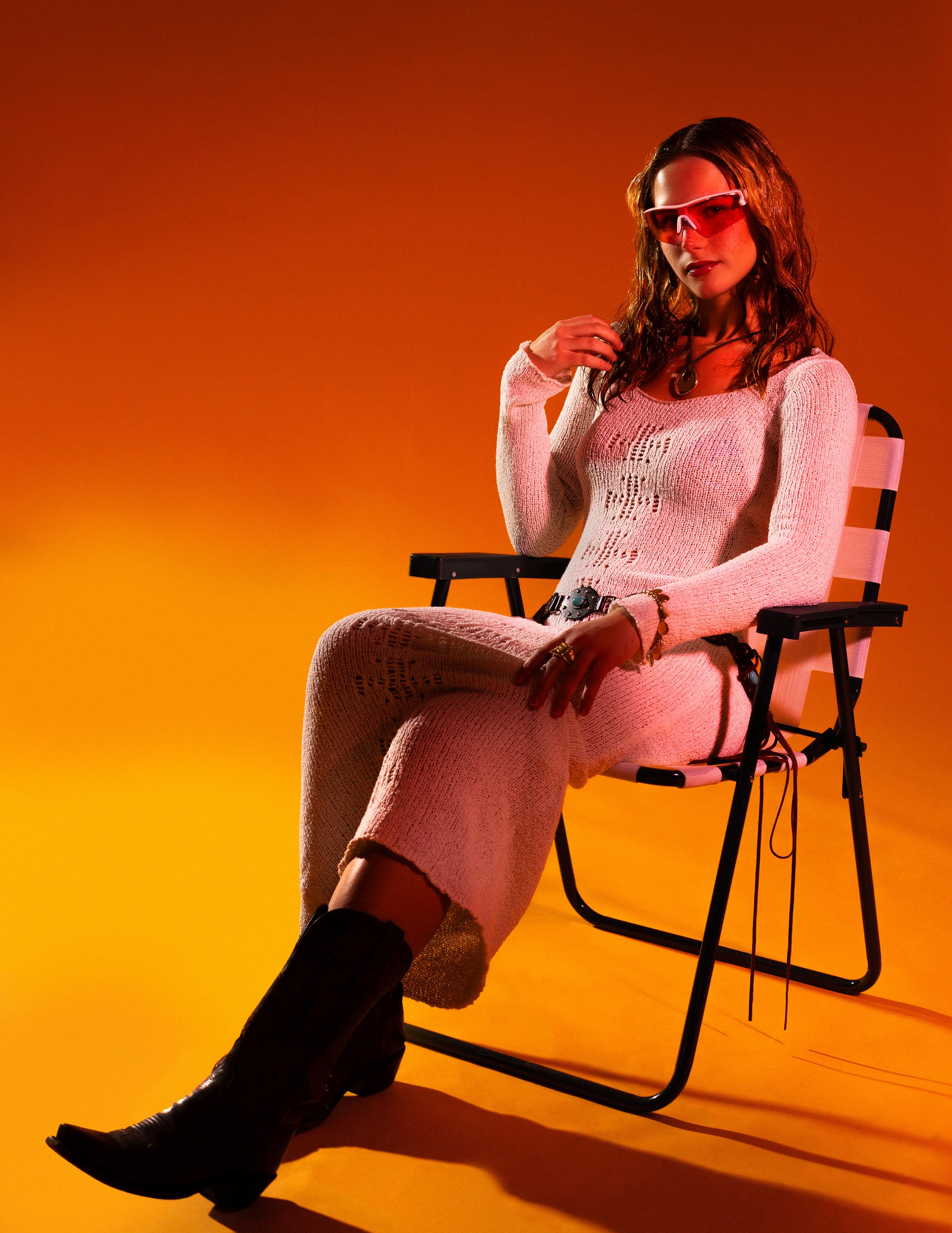
State College: a place where small businesses can thrive inside a tight-knit community. Hairdressers come a dime a dozen, and while some students stick to their roots at home, others have decided to branch out and patronize local businesses. For those within the Black and brown community, State College is a desert of diversity in the beauty and health industry. But where do these residents and students go? Some have chosen to stand up to the world of “The Real Housewives” of hair by using their own gifted hands.
Like the majority of middle America, diverse residents growing up in predominantly White areas call for the act of survival for basic “needs.” The lack of population diversity is showing its hand within communities. According to a 2021 State College census, the five largest ethnic groups in State College are White (Non-Hispanic), Asian (Non-Hispanic), Black or African American (Non-Hispanic), White (Hispanic) and multiracial (Non-Hispanic.)
To combat the absence of beauty and health resources, students on campus have become more resourceful. For those not able to travel home to retain their maintenance, they can now turn to student-run businesses on campus. Third-year biobehavioral health student Gracia Nsingi is taking her passion of working with her hands to impact the community.“Over the course of time, I noticed that people in my community shared the same distress and decided that it was time to utilize my gift to make a change,” Nsingi says. Nsingi’s business, CrownedByGraceN, is a
student-run operation providing services to Black students on campus looking for a place to get their hair done affordably. The business name stems from Nsingi’s first name, which means the “grace of God’’ in French. Regarding her name’s meaning, she wanted the business’s title to signify how her clients would get their hair done, and they would not only be “Crowned By Grace,” but also crowned by the grace of God. Services from her business range from knotless braids, stitch braids, plaits, locs, re-twists, wig installs and so much more.
However, what about all the locals who are forced to look deeper inside their community and sometimes are forced to create their own spaces? Government programs like the Small Diverse Business Program can encourage more individuals to expand their small businesses. State College cosmetologist and Black business owner of NU BEAUTY Callie Turner has called to help make this change. NU BEAUTY is an established beauty shop providing all cosmetic services to those in the area. Starting with a kiosk inside the Nittany Mall, Turner has turned her thriving business into a full-on beauty bar in 2024. While they do not provide hair and nail services, the business not only provides Black women with hair products but also services to local patrons in the area looking for beauty maintenance. While the salon does not discriminate and services all clients, it creates a safe place for Black and Brown women to feel confident. “There are a lot of things I am learning on my journey, and I would like to empower people. Entrepreneurship is difficult,
but it is worth it. I feel like people just don’t know how to go about things just like me,” Turner says. “I can totally relate to having passion and drive but no resources. Black women need to know that you can accomplish anything with hard work, discipline and skills.”
NU BEAUTY started as only a product-based company with the incorporation of services. Their motto is that “everyone is beautiful, and the brand enhances that beauty.” They aspire to expand with more services and products, as they see an opportunity to provide great services and products to the community. While diversity and inclusion might be seen as pandering to some, real lives are affected when there is zero support within the community to make changes. Support local businesses, not only to support your community economically but also to inspire proper change.
Nsingi believes that her legacy within the community first starts with students like herself and business owners like Callie Turner making a change every day in the lives of this community. The power these gifted hands hold is an untapped potential waiting for the community to embrace it with their full support.
“I would like for the State College/Penn State community to remember me for the compassion I showed towards my clients, alongside my diligence towards my business as a whole,” Nsingi says. “I would also like for them to not solely remember me as one who has brought change in the domain of hair businesses but in the hearts of those I had interacted with.”
14
The term “routine” is seen everywhere nowadays College students, even those who claim they don’t like planning, all have routines. After repeating the same steps for so long, you start to develop a subconscious to-do list that you may not even realize you have.
There’s a routine when you wake up and get ready for the day, one when you arrive home and then one before you go to sleep. That’s not even counting the days when you head to the gym. How do routines play a role in your skin’s balance, and how do you know if it’s a perfect match for your skin? Your skin routine plays a crucial role in managing day-to-day stress, aging and disease prevention. “[A skincare routine] helps fight signs of aging and also can protect our skin from UV damage that contributes to skin cancer,” Dr. Jean Charles, a board-certified dermatologist, says.
With an overwhelming market of products, people can struggle to choose the right products for their skin needs. If you don’t know where to start creating your skincare routine, you should talk to your dermatologist or research the type of skin you have. “It’s important to figure out what skin type you have such as dry, oily, acne-prone or combination,” Charles says. “Also, [you should find] what particular skin concerns you struggle with, whether that’s redness, hyperpigmentation, dryness, etc.”
the differences between morning and night care is important, as they equally serve opposite motives. A morning routine “protects our skin from the daily environmental stressors that we face such as UV rays, pollution and oxidative stressors,” says Charles. She highly recommends applying sunscreen daily to help protect your skin from the sun. Dr. Fatima Fahs, board-certified founder and dermatologist and of Dermy Doc Box, explains that a nighttime skincare routine is designed for treatment. “For example, those who want to address signs of aging may choose to incorporate a retinol, and those with hyperpigmentation might choose an exfoliating acid,” says Fahs. She states that skincare routines, on their own, can honestly be quite enjoyable. “[They] can feel ritualistic and relaxing in the evening, and invigorating and energizing in the morning,” says Fahs.
elaborate or potentially damaging to how skin properly functions. Charles explains that people do not need to have a 20-step skincare routine or pay extreme amounts of money for serums and lotions. “You can get great skin from as little as three products (cleanser, moisturizer, and sunscreen,) and you can discover great skincare products at affordable prices,” she says.
For those lost in the social media skincare storm: “Skincare is definitely trial and error in terms of finding the right products for your skin type and concerns, but it’s definitely possible to feel good in your skin with consistency and good skincare,” says Charles.It’s important to remember that your skin is unique to you, and with time, you can find a system that keeps your skin healthy and glowing.
develop both a daytime and nighttime routine. Distinguishing
Skincare routines are everywhere on social media. “Get Ready With Me” videos contrast with the properly named, “Get Unready With Me.” When watching these clips, it’s easy to buy into products influencers claim are miracles. Be cautious of this sponsored content, as it is not a personal recommendation from a dermatologist. Dr. Fahs described that content found on TikTok can have positive effects, as skincare content can encourage viewers to create a consistent skincare routine. However, she also talked about all the downsides of skincare social media content. “Not all skincare routines are beneficial, and not all products are appropriate for all skin types,” says Fahs. “What may be a great skincare product for one person may potentially cause irritation or worsening skin for someone else.” Media content can advertise routines that are either extremely
Skincare routines can be confusing, and you might feel at times like there’s no rhyme or reason. Don’t worry though, trends and social media tend to overcomplicate matters of the skin. The purpose of having a daily routine is to make you not only look good but also feel good. “Keeping a skincare routine can be a form of self-care,” says Fahs. Beauty influencers and extravagant advertisments can be misleading, as what works for them may not work for you in the long run. In your routines, make sure you’re taking care of your skin in the way that best benefits you. After all, it’s just you and your body against the problems you face each day.
this isn’t about the Kid Cudi song. Those who are skincare-conscious often
No,
15

16

We as humans, as individuals, are ever-changing. Some of us play around with our image so often that our identity is never the same. For others, we tend to stick to what we know, changing up our hair or style every few years, if that.
Society instills this belief in us that we have to look young forever. It claims we are losing ourselves if our body changes its shape, we are “going through a phase” when our hair looks too different from the norm or we are trying to prove something if we completely change our entire look overnight. Our appearance is judged by the characteristics we present, rather than valuing the body’s natural changes.
The amazing truth is that our bodies are so powerful. There are changes happening inside us constantly. Whether that be over many years or overnight, we truly never remain the same. The challenge is connecting with our bodies to realize these transitions, and overall understand ourselves.
“When I think about connecting to my body I really am trying to be attentive to what seems simple, but all parts. How am I thinking about my body? What am I actually feeling related to different parts?” Jen Anderson, assistant biology professor in the Eberly College of Science, says. For many of us, we are not the same person we
were 10 years ago, five years ago or even last year. We may not enjoy the same food we have previously loved or do the activities we used to enjoy. This is not a bad thing by any means; it simply suggests that our body is evolving — it is literally growing alongside us. Now, this could scare you: many of us naturally have a fear of getting older. Or, this could excite you and inspire your drive to better understand yourself.
“As you move through life, there’s going to be those different hormonal changes that are related to this sort of peak childbirth time,” Anderson says. “But then as you get to your mid-20s, late 20s, something else changes. I can’t just stay up as late anymore, and I can’t eat everything I want because then my skin breaks out, or I am gaining weight and then again start changing throughout my 30s and 40s.”
When you are nourishing your body with what it needs to feel good, it will directly reflect your outward appearance. It is hard to always stay on top of doing the right thing for your health; however, when taking care of yourself becomes a lifestyle, your health, mood and overall well-being improve. Establishing that connection between knowing how to make your body feel good and executing those needs could be the answer to embracing your ever-changing self. “It starts with
the moment of waking up,” Anderson says. “I like to take an assessment that I’m awake. I tune into everything else, trying to just go through how that sleep was. And oh, that’s interesting, I remember not sleeping well, or I don’t remember anything. I can use that information later in the day if I need to. How does my body really feel?”
For those who fear change and are constantly mourning the old you, try to attempt to shift that perspective. Your body is quite literally telling you to. What’s the point of going through transitions within you if you do not embrace it on the ouside? Each phase of yourself has its own beauty within it. Your appearance had factors that you may have loved and others that you despised. Instead of grieving the parts you loved, celebrate how you have changed.
The old you is dead. Yes, there are still parts of that person that are instilled within you today, but you are not the same – in more senses than one. Learning to change with your body, not against it can open the possibility of an even better version of you than before. You are constantly becoming new again, and that notion is a beautiful thing to remember.
“I think everybody’s beautiful, right? We all just have it because we are all using our bodies to express who we are.”
18

PHOTOGRAPHY BY: KATHERINE WOODRUFF
A typical Friday for some college students includes a cup of coffee in the morning, one too many shots of tequila at night, accompanied by a few vape rips and two Advils in the morning for the brutal hangover headache. Within 24 hours, you have managed to incorporate four different drugs into your daily routine. No wonder we feel like shit all the time. But really, what does this mean for our health and wellness?
Stimulants and depressants are classes of drugs. Stimulants, as you can assume, are used to stimulate your central nervous system, like caffeine, nicotine, cocaine and amphetamines. On the other hand, depressants reduce stimulation in your central nervous system, like alcohol. Lastly, there are cannabinoids: natural compounds found in the cannabis plants, commonly known as weed. These three drug classes are the most commonly used by college students, even all three in one singular day.
But, so what? You might be thinking you can control your alcohol, drink a “normal” amount of caffeine and only smoke weed at night, so wherever this is going doesn’t apply to you. Did you know that it can take up to three days for nicotine to leave your bloodstream? Or that using tobacco and cannabis together stunts your brain development?
Not to scare you, but it’s about time to know what’s going on in your body. These normalized drugs that we take and consider harmless may be misrepresented, not to mention the overlapping effects of taking multiple at the same time.
Dr. Ashley Linden-Carmichael, associate research professor works in the Edna Bennett Pierce Prevention Research Center at Penn State. Her program of research focuses on identifying influential and underlying psychosocial predictors and consequences of high-risk drinking behavior, including very high-intensity drinking, blackout drinking, alcohol mixed with energy drinks and simultaneous use of alcohol with other substances, such as cannabis. “If someone has a concern about whether they’re experiencing substance abuse, and it feels like their life is starting to center around substance use, that’s when it becomes concerning,” Linden-Carmichael says.
Substances have their effects in isolation. Whether they choose either alcohol, nicotine, cannabis and/or caffeine, students often take two or more substances in the same day –– but one of the most dangerous combinations is alcohol and caffeine. “When people mix alcohol and caffeine, caffeine can actually counteract the effects of alcohol that someone feels so they can feel less drunk than they actually are,” claims LindenCarmicheal. “But the problem is that caffeine doesn’t reduce the alcohol.”
A reduced feeling of drunkenness because of caffeine could lead to more alcohol consumption, leading to more potential harm. And, possibly even more prominently in college students, the combination of weed and alcohol can produce a “cross-faded effect” that can do more harm than good. “People decide to engage in mixing cannabis and alcohol because it can make them
feel better and relaxed. But, what we also see from tons of research is that when people mix, they actually experience more harm,” says LindenCarmichael.“This can be social issues like getting in a fight with a friend at the bar, or it could be that they’re more likely to black out. But, we also know that there are also long-term effects like the risk for alcohol use disorder or cannabis use disorder.”
The use and abuse of substances can be called “normal” behavior for students at large state schools like Penn State. It’s hard to tell whether this cycle is something a student will “grow out of” after graduation or continue to be an unhealthy habit. “The longer you do it, the harder it is to break those patterns,” says Linden-Carmichael. It can be hard to avoid the tempting drugs and substances that are so easily accessible in college. The “college” lifestyle of using and abusing, in isolation or together, makes for some surprising consequences.
As you know, mixing substances can make or break a night and many nights to come. Avoid mixing marijuana with other drugs, avoid mixing different types of alcohol and most importantly, know what you are putting in your body. The kind of lifestyle you hold today can weaken your tomorrow, so be wary of the overlapping effects. A night out on the town can be exciting, so don’t let risky substance combinations ruin it.
20

Social media: today’s global disseminator for aesthetics, fitspo and diet culture — intermittent fasting, keto, juice cleanses and the season’s newest fad diet.
Social media, movies and celebrities bolster the idea that exercise creates an aesthetic, a body type that can only be achieved by a rigorous, disciplined exercise routine — even when the look is really only attainable through cosmetic surgery. This widespread obsession with looks and appearances, whether someone wants to look thinner or more muscular, can easily detract from appreciating the real benefits that regular exercise provides.
Dr. Wendy Suzuki, a neuroscientist at New York University, conducted an unintentional exercise experiment on herself that became the core of her research. When she started to exercise more, she told National Public Radio that her memory seemed to be functioning better. “My hippocampus that I was studying in my own lab seemed to be working better, and my focus was working better,” she recalls. “And that is what really made me sit up and take notice and say, what’s going on here, and how can I get more?”
What if exercise doesn’t have to be for getting thinner arms or a flat stomach? What if exercise could be giving your brain the everything shower that it desperately needs to perform at its absolute
best in even your most challenging class? Suzuki explains that muscles release protein when they are working, the liver releases ketones, and the fat tissue releases substances. These signals go into the brain and release what are called “growth factors” in your brain. “These growth factors we know are the key to growing new hippocampal brain cells,” Suzuki says. “There are lots of other neurotransmitters and neurochemicals that get signaled that give you what I like to call a bubble bath of neurochemicals every single time you move your body.”
Henriette van Praag, an associate professor of biomedical science at Florida Atlantic University, noted the positive effects of exercise on the brain in young people within her study. She exercises regularly and recommends her friends and family to do the same. “A positive correlation between physical activity and learning and intelligence scores was reported in a meta-analysis of schoolage children. In addition, in college students’ reaction time and vocabulary learning were faster immediately after intense running,” van Praag wrote. “Similar results were obtained in young adults after 12 weeks of aerobic training (average age 33.) This research indicates that, rather than observing a ceiling effect of exercise in young people, being active makes a functional diffeence.” van Praag recommends aerobic exercise, like
running, swimming or biking, to get the blood pumping and most effective brain benefits. In her studies on mice, she found that just running significantly increased the number of cells in their brains. “One of the biggest surprises I’ve had in my research was that just exercise could have such a profound effect on the structural part of the brain,” she says.
Exercise can cleanse your brain and not only help you improve your performance academically but also improve your mood after just working out once. A 2017 study by Suzuki and Julia Basso, assistant professor at Virginia Tech, found that “The three most consistent cognitive/behavioral effects of a single bout of exercise in humans are improved executive functions, enhanced mood states and decreased stress levels.”
The brain bubble bath is perfect for helping college students improve. Developing a healthy relationship with exercise and the benefits that regular workouts can give you improves cognitive function and mood stability throughout your adulthood, even when your professional and personal life feels stressful. You don’t need to spend half of your day in the gym to feel these effects. Start by grabbing a friend and going for a walk, planning an activity like basketball or racquetball at the Intramural Building or signing up for a guided group exercise class
21
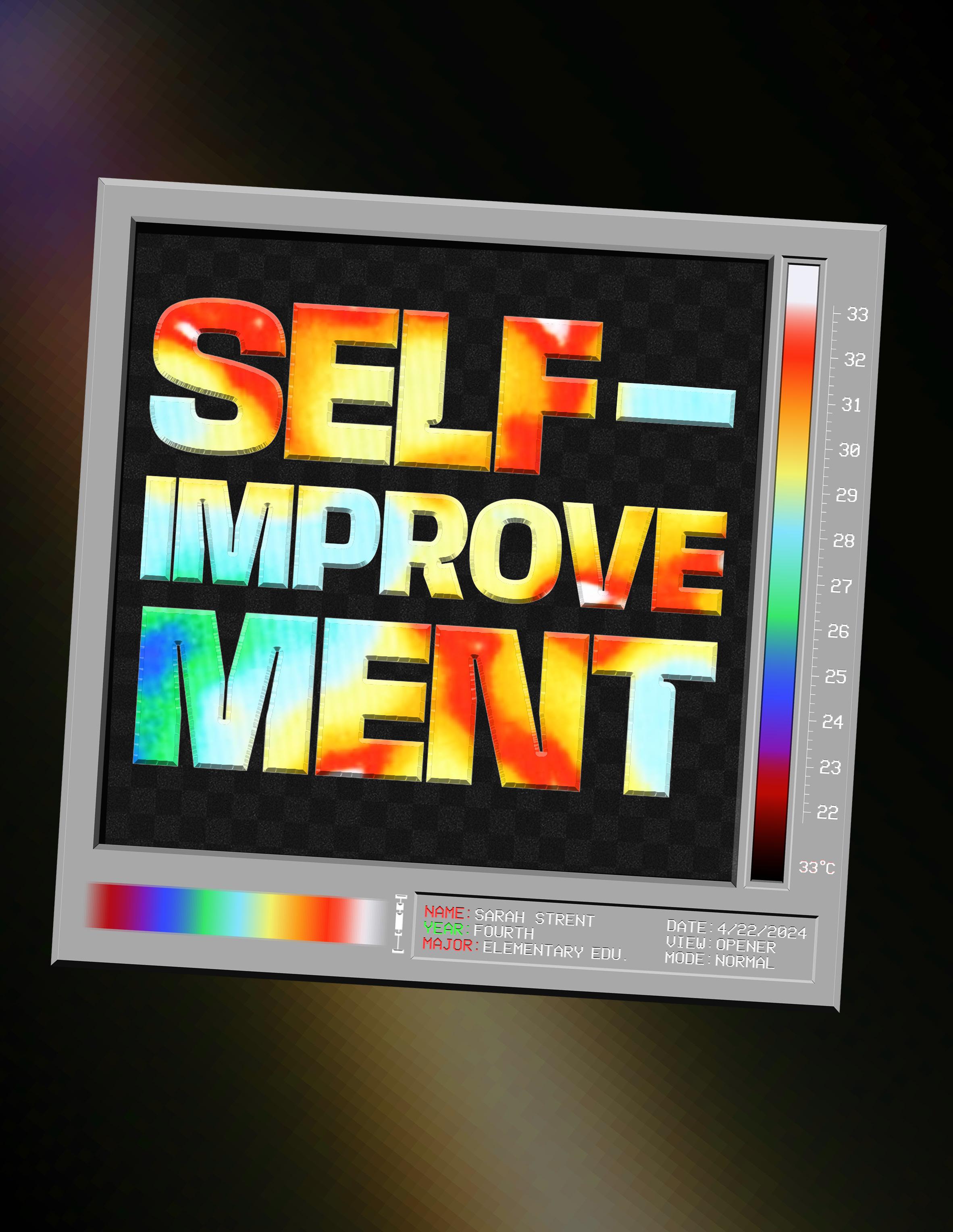
22


I have lived your life. Well, not your life exactly. We played different sports, had separate friends and grew up years apart. But, I have lived your life. I know the exact cabinet that never closes in the kitchen, and I recognize the same footsteps of our family members that you too are familiar with. To say we are the same person is a lie; I know we are not, but I have been where you are. I had the biggest crush on a boy and then contemplated how to end things a week later. I have had fights with friends that ended with me sitting on the same couch that you do now, crying to Mom and Dad about how unfair my life is. With each and every moment I’ve experienced, you were always right behind me. Sometimes, you were trying to eavesdrop with your ear pressed against my door, and other times, this serves as a metaphor. The life I lead now is the chapter you too will soon experience.
You are my little sister. People have said we look alike. I will admit we have similar noses and maybe our facial structures replicated each other, but other than that, I never saw it. I never did see how closely related we are to each other until I left for college, and you started asking me for advice. Me? Advice? I found this notion absurd. However, the more I let this conversation settle within me, the more I started to realize I have some insight into what you are going through. I did experience it too, after all. I never thought of myself as someone to aid you. I could tell you what to do. I could scream at you for taking my
clothes. I could share an eye roll about a corny joke that Dad makes, but I cannot help you. That’s what our parents are for. I, of course, am not your parent, but I am also not your age. I suppose I can let you in on some life secrets I have previously learned.
The issue is in navigating what to tell you and what to let you learn yourself. The role of a big sister is particularly unique in life. There is little that compares and rarely any other type of sibling relationship that is the same. Being born into the role of the older sister has placed me in a position of mentorship. Without ever acknowledging it, you are constantly looking up to me and seeking advice when you feel that you trust me the most with the situation you are in. Maybe you’re not sure whether to get into a relationship with a boy or you’re having trouble ending a certain situationship with another. You know that I have been there before, so what should I tell you? Is it beneficial for you to go through my mistakes and learn from them? Or is it better to tell you exactly how to handle every situation?
With each new question you bring to me, I reminisce on the time I was first asking myself the same thing. As with a lot of things in life, learning through trial and error is the best way to fully grasp the answers. For others, however, it is beneficial to seek advice and learn from stories to avoid something entirely. I did not have an older sister to let me in on the ladder, so I too am going through this along with you. Since I
left for college, getting a phone call from you has been one of the best parts of my day. I know that there is not only a purpose to why you are calling but also the underlying feeling of missing each other. You ask me whether it is a good idea to go to a party tonight. I let out a laugh, recalling my first highschool party experience. I fall into the thoughts inside my head. “Wait I cannot tell her that, can I? Do I want her to make the same mistakes I did and eventually grow from it as well, or do I tell her precisely what happens and ensure that she does the ‘right thing.’ She is a teenager, after all, the right thing rarely crosses your mind on a night out.”
Another time you need help ending things with a boy. I debate if I take the rational approach and tell you what I wish I had done or let you in on my notorious ghosting move. The constant debate in my head on what is the best thing to tell you at the time is an ever-lasting battle I continue to fight.
I truly love you more than I love myself and I wish you more success than anyone. I will be the first to show you a good time but will always have my eyes on you. I will laugh-scream the harshest words at you, then come into your room when I hear your cries from the mirroring wall. I will forever be your biggest critic but an even bigger admirer. Your constant lantern in the dark and your front-row biggest fan. We are so incredibly different, but likewise one and the same. You are a version of me, and I of you.
24
A new fresh coat of paint on our nails and toes can feel as rejuvenating as if we are starting a new life. We shape our outfits and attitudes based on the shades on our mani-pedis. We encapsulate a clean girl aesthetic with Bubble Bath or our revenge era with a darker and sexier red. After that high of freshening up our nail colors, our pedicures are forgotten. We go on about our lives while the paint holds on to its glory coming out of the nail salon. Our feet go wherever we are, experiencing that kind of whirlwind romance or mental breakdown about our unknown futures. Our nail polish sees every raw moment in our lives, but we subconsciously let it linger and attach to our ongoing phases.
Deciding on a new shade to paint on our hands and toes can feel daunting. The wall with every shade imaginable can make our decisions harder as we pick up every bottle, compare colors and call our friends for a second opinion. We stumble upon dark blues, bright reds, chrome and glitter that stray us away from our initial instinct to stick to the basics. With each nail polish, we can’t help but imagine every outfit and personality tweak to go along with each shade.
polish remover-infused cotton balls. As people, we repeat old, bad habits because it has become almost like an instinct. Comfort can prevent selfgrowth and break through barriers we have placed in front of ourselves.
It’s the first day back at Penn State. We all feel refreshed and at our peak walking around State College and awaiting the chaos of sylly week. As we took the summer to cleanse and relax, we prepared our minds and bodies for the upcoming chaos that would occur once we stepped back into our favorite places with all of our best friends. It is important to start the new year off fresh and clean with our beach tan, styled hair and polished nails.
We left our disheveled selves from finals week last semester in the past and came back to State College as a whole different person. Our past mistakes from last semester flaked off with our splotchy self-tan and chipped nail polish that lasted way too long. As we enter our new era, the new polish on our hands and toes is about to endure what adventures the new semester has in store for us.
A new manicure feels like a clean slate. Most words that come to mind to describe that feeling of a fresh color painted on our nails and toes most often include “clean” or “put-together.” The power of nail polish makes us feel like we have our shit together. As some may say, fresh nails can feel life-changing. “I instantly transform into a baddie and shove my hands in people’s faces so they have to tell me they look good,” says Dani Farino, a second-year Penn State student, who often changes her nail color – almost every two weeks to be exact. A wave of confidence hits us instantly with that fresh coat of nail polish. Jenna Santoni, a first-year Penn State student who shares a similar passion for nails to Farino, describes her boost of selfesteem after a fresh manicure.
“I always feel so much more confident and girly when my nails are done. Even just a simple colored manicure or short acrylics can boost my confidence so much, and I can’t stop staring at them,” Santoni says. Second-year student Brianna Sawyer qualifies how long she lets her pedicure polish sit until it’s time for a fresh coat. “Until the polish comes off,” says Sawyer who, like most of us, waits until the very last second to change up our pedicures.
Nail polish doesn’t last forever, yet we cling to every last bit of polish that survives months on our toes. The paint becomes comfortable on our nails, intentionally sticking on and hoping to avoid nail
Our nail polish sees all the raw moments we face. Our experiences and memories that stick like our nail polish can hold toxicity, infiltrating our systems with counterproductive behavior that stunts our growth. Although hidden under our socks and shoes, our toenail polish feels every step made while the rest of our bodies physically experience those big or small moments.
People are constantly evolving throughout their lives. We go through phases and trends that dictate how we wish to be perceived by others. Along the way, people attach themselves to the memories, objects or other people that stay frozen in that time. Old coats of nail polish represent our past lives, repainting over them with the same old habits and repeated mistakes until we decide it’s time for a new start. A new start feels terrifying as we wonder what the unknown can hold for us. Hitting the restart button can allow us to release those bad habits and past mistakes that have lived inside of us for too long.
Our old nail polish that slowly chips away on our feet represents this gradual process until we decide it’s time to use the polish remover. Our pedicure polish sees us through our highs and lows. As the last flecks of polish gradually chip away, we become one step closer to blossoming into a better version of ourselves
25

Social norms around relationships and love have changed over time. Some say chivalry is dead, and some believe they were meant to live in a different time. With social media and the pressure of new social norms, relationships today tend to be very rushed. No matter how you meet someone, how you connect or how long you’ve known them, the first “I love you” is always important. In any relationship, most people wait to hear those three words.
The first declaration of love often comes a few months into a relationship. However, as silly as the term “love at first sight” might sound, for some, that is the case. Of course, not every couple experiences “love at first sight” but rather learns to love each other at different points in their relationship. “There’s really no time limit on loving someone. You could click with someone right away or have a slower start,” says Ashley Keegan, who has been with her boyfriend for almost a year. “It was easy for me to love him; I always did. We were friends first. I just loved him differently after we started dating.”
In our generation, the act of saying the first “I love you” is more romanticized than internally admitting to yourself that you have truly fallen in love. The internal realization marks a milestone even more significant than the first vocalization of “I love you.” For many, the concept of falling in love is incredibly scary because admitting that you are in love risks getting hurt.
There is a difference between loving someone and being in love. You can love anything: friends, family, pets and partners. But, to be in love means feeling a deeper connection with someone beyond the love you feel for your friends and family. Being in love is an idea that scares many away from truly being in a committed relationship. The fear of commitment, betrayal and fully giving your trust to a person creates obstacles to letting yourself fall in love.
More people are trying to find love rather than just letting it come to them. Hearing that someone loves you is extremely special, and you will never forget learning that someone else has developed such strong feelings for you. However, falling in love and being in love is essential when thinking about a relationship long-term. MarieAnne Perreault, an instructor of the philosophy course, “Love and Sex,” says, “Falling in love and admitting to oneself that we are in love are less valued because they stay mostly internal and private and, as such, do not risk deception. It is true that we can convey our love through means other than saying ‘I love you,’ but stating it is generally considered a milestone in a relationship.”
“I believe the importance given to saying ‘I love you’ lies in the implication of risk-taking and the explicit chance of non-reciprocation,” Perreault says. “One can admit to oneself that they are in love without it having any impact on the world or on the relationship with another
person.” Falling in love adds on many deeper meanings to a relationship. When thinking back to high school relationships, many people don’t realize how their perspectives on love may have been naive. Social media has also increased the normalization of toxic behavior in monogamous relationships.
Young people tend to think that anything someone does in a relationship is “out of love.” However, when a relationship turns toxic, love is not in control. After reflecting on the differences between her high school relationship and her current relationship, Keegan says that she can see a difference.
“In my past relationship, I thought I knew what love was, but it was all very surface level, toxic, and not real,” Keegan says. “After being with my current boyfriend, I have noticed a total difference in the way I’m treated and see that’s how it should truly be.” Keegan says that her current relationship has made her think about her future.
“I noticed I was really in love when I started thinking about what it was going to be like postgraduation with him.”
The concepts of the first “I love you” and the “I’m in love with you” mark significant milestones in any relationship. The moment and realization that you are in love with someone, especially when it comes to wanting a future with them, might just be one the most special and intimate parts of a relationship.
27


PHOTOGRAPHY BY: JULIANA TOOHEY
There’s always one kid who went by a distinct name, established by either their friends or family. Nicknames can differentiate friends with the same name or just randomly catch on for others with no connection to their full name. Sometimes , nicknames pop up from the places you would least expect. They come from a drunk night with friends, that one sibling who couldn’t pronounce their r’s right or a teammate who gives nicknames strictly for games. Our names carry our identity and how others can perceive who we are. People form their identity around their given or chosen names.
What happens if they merge? A collision between two identities can create confusion about who we are and who we want to be.

Our names are generated by our parents, stemming from an older family member or the baby name list that we all secretly have in our notes app. The foundation of our social identity is our birth-given name. As we grow and meet more people, having the same name becomes a more common occurrence, forming the need for nicknames. People assign a different name to someone else, and it somehow fits, as if their birth name never existed.
While people try to build their social identity based on their names, their personalities around different groups of people can change based on their names. Alter ego means “alternate self,” as it only reflects a part of our identity. We can emerge into our alternate selves based on different circumstances. Our personalities take a shift where we may take riskier actions or completely transform into the opposite of our true identity.
Our identity is often ever-changing through temporary interests and also personalities. Our very own nicknames derive from anything. Molly Countermine, a teaching professor of human development and family studies at Penn State, dives into the importance of our social identity and how nicknames can impact who we are.
“The spirit in which a nickname is given matters; most nicknames are given lovingly as terms of endearment from parents or other primary caregivers,” Countermine says. Our birth-given names don’t always feel like the perfect fit. Although a nickname takes more time to develop, it can act as a substitute for that perfect glass slipper and encapsulate how we truly feel about ourselves.
“Our names are especially important if we feel they don’t fit who we know ourselves to be,” Countermine says. Individuals can create or adapt a nickname to their personality in a way that just makes sense. “Anytime a person is given (or gives themselves) a nickname they love or can really relate to, it can boost their confidence which in turn can improve their well-being and sense of autonomy and agency,” Countermine says.
As developing people, we go through phases and names that fizzle out with time. When the nickname from our childhood sticks around a little longer than expected, it evolves alongside our developing identity. Our interests have changed from grade school to now, yet our nicknames still hold those memories from years ago. A nickname can simulate an internal purgatory where we feel in between two different chapters in our lives.
Changing your name can feel like pulling back and forth between the nickname your family and friends use and the new name that you are trying to establish yourself as. A name change is a total rebrand. Compared to a new clean slate, resorting to our birth-given names can allow someone to transform their social identity. All of the past mistakes, bad habits and bad memories associated with our old nicknames can feel erased once we reclaim our birth name. It takes time for people who went by a fun, light-hearted nickname like “Jimmy” to shift into a more sophisticated “James” that desires to be taken more seriously. “Jimmy” carries our childhood memories filled with park adventures, a colorful imagination and the universal awkward phase from middle school that lasted a little too long. “James” brings a whole different perspective to our lives.
The birth name symbolizes our maturity and what our future holds. We are more than just a nickname from middle school. Our lives are not stagnant. We continue to evolve with newfound interests and environments that shape how we wish to be perceived. Nicknames can come and go with time, but the ones that stick — voluntarily or involuntarily — can truly make an impact on our identity more than we think.
30
What constitutes something as art? Is it the pure, raw talent taking shape on a canvas? Look at the meticulous details of Michelangelo’s “The Creation of Adam,” and no one will refute that it is indeed art. People nowadays say to bring back Renaissance painting, but maybe they mean to bring back art that the average person will never achieve. For his time, Michelangelo was gifted with hands from God himself.
When Jackson Pollock used a machine to splatter paint on a canvas lying on the ground, it was seen as revolutionary. As art became more abstract, would people call that talent? Abstract was the antithesis of realism. Art mimics human movements, and the movement of abstractism came along with the two World Wars igniting feelings of hopelessness, despair and primal emotion. Pollock taught us rage on a canvas. Mark Rothko painted a line in the center of a canvas and said it was pure human emotion. They return to human emotions that can only be explained with mechanisms that exist in the brain.
The theme of art is this: art keeps moving as society and technology develop. Leonardo da Vinci studied anatomy for years, and artists alike used his studies of the precise human body to create their own art. Skipping many years down the line, the first camera was invented, and then photography was integrated as art. Most people can pick up a camera and use it to take a picture. The picture that you took of your Sunday brunch: is that art? Or are the photographs that won in the “National Geographic” art? This is how artificial intelligence (AI) is measured, as well.
Equalize the camera to AI. It is a tool that many people have access to, and in just a few minutes, they can produce an image. The beauty of it –– you can capture whatever you wish for. Similar to AI, you can use text-to-image and tell it to produce a picture of a clear blue sky with stars in the background in just minutes.
Stephanie Thomas, affiliate professor of art history at Penn State, teaches her own course on using artificial intelligence technology for art creation. She says that the discourse surrounding AI in art is similar to when the camera was first developed. “It [AI] is the same thing as the camera coming into use with painting, in thinking of the way that camera affected the way people painted portraits. Then the idea comes in – is photography art?” she says. Nowadays, most people do consider photography as art. Of course, this also comes with discretion – but it is easy to tell apart what photographs were intended to be art. With AI, just as the camera, it is a tool that demands to be learned. It is not the product itself that is art but rather the intention and process. One day, people will see art made by AI as real, too.
“My class is built upon the design-thinking methodology, where it’s about creativity and imagination,” says Thomas. “You imagine a place or what a work of art looks like. Then, when you start to apply it physically in some way, to shape it visually, then it becomes creativity. I think that AI will fit somewhere in between there.” As art continues to evolve, as it has been ever-evolving since prehistoric cave drawings, it will have an audience. To be an artist is not just about having talent because the practice itself is subjective and personal to their own. While AI may be under a lot of scrutiny right now, for various (and valid)
reasons, it being in the art world can be a neutral thing and not just positive or negative.“This will give a lot of creative freedom to a lot of people who aren’t technical artists. If anything, it will make people feel more artistic and creative,” says Thomas.
As a part of her class, Thomas has allowed her student artists to create their own exhibitions using AI and virtual reality. This has had a big emotional impact because, for the first time in their lives, students can see their own artwork displayed on a wall, right in front of their eyes. This would have never been possible without the help of scary robot AI technology.

People will argue about the usage of AI and art for the next foreseeable future. People have their preconceived notions of art, and it is unique to all. Some people demand to see fresh, raw talent displayed on a blank canvas to be an artist. Some people see a banana taped to a wall and immediately resonate with it and applaud the artist. “You take the good with the bad, but I’m optimistic. And it’s not going away, so you might as well embrace the future,” says Thomas.
Art is a part of the human inquiry. For as long as humans are alive, art and artists will always exist. Traditional art will always exist, as well ––that will never disappear. There has to be a line for people to accept that technology can be used as a tool for accessibility and that it can rekindle people’s emotions when it comes to being creative. Creativity is infallible, an indestructible force that will keep reminding us that humans are always looking for ways to create more and more.
31

32

 WRITTEN BY DANI ARCARO
WRITTEN BY DANI ARCARO
Wanting a healthier lifestyle for yourself and becoming motivated to improve your overall wellbeing creates a rewarding feeling that nobody but you can experience. The seemingly intimidating powerlifters that take over machines may make you feel insecure about only lifting 15 lbs when they are lifting 60 lbs. You start to become overstimulated, fearing as if all eyes are on you while you work out. The first step is to put on your favorite gym clothes and break through your gym fears.
involved. She was also previously a member of the Penn State club PSU Gains for Girls. “When I first got to the gym, I was super nervous that people would be judging how my body looked or how little I could lift. The biggest intimidating factor is that the gyms, at least the ones I have been to, have a way higher male ratio than female,” Angelozzi says. “The main thing I have realized that helped me get over my intimidation is that everyone is only paying attention to themselves.”
of the basics and encouraged me to go with them even if I wasn’t feeling up to it some days.”
Entering the gym for the first time can be an intimidating experience for many, with fear and self-consciousness acting as barriers to a healthier lifestyle. No one should have to go through that alone to develop a healthier lifestyle. Exploring your feelings of judgment, comparison and fear of the unknown can help you get over your fears. Rutgers University third-year student, Callen Braga, began his relationship in the gym of his high school, to improve his athletics, feel better and become stronger overall.
“Having a partner when I first started going to the gym was definitely helpful. Having [a partner] helped a lot with gym anxiety and staying consistent in going everyday,” Braga says. Going to the gym with a friend adds a social aspect to your workout routine. This partnership can turn exercise into a social event, providing a positive and supportive atmosphere that counters feelings of isolation or anxiety.
Penn State third-year student Grace Angelozzi began going to the gym around the same time COVID-19 started to try to feel more fit, but once she entered college, she took exercise more seriously and realized the many benefits
Breaking through what you are scared of is the biggest motivation of them all. A feeling of anxiety when you are first entering the gym may deter you from going back, so bringing a friend with you creates a sense of accountability. Knowing that someone is relying on you makes it more likely that you will stick to your gym routine, reducing anxiety about inconsistency. Your gym buddy can be your biggest support system, someone you can turn to when you need to be hyped-up or just someone to share all your progress with. “A lot of my housemates would go to the gym consistently so even if I did not feel like going one day, my roommate would push me to go anyway,” Braga says.
Building a large supportive network of consistent gym-goers is essential for personal fitness success. This social aspect not only makes workouts more enjoyable but also strengthens the foundation for a consistent and successful fitness journey. “I much prefer going with a friend to the gym. It makes the process so much more enjoyable and having a friend there to motivate you can be really encouraging,” Angelozzi says. “My biggest support system when I first got into the gym was my friends. They were the ones that taught me all
The gym community might seem intimidating or scary. Comparing yourself can lead to feelings of inadequacy, and concerns about being judged for your fitness level can create anxiety. The presence of individuals with seemingly advanced skills or impressive physical fitness can contribute to selfdoubt. This fear may stem from a perception that everyone else at the gym is more experienced or in better shape and that all of their eyes are on you. “The whole gym community is super supportive. Everyone there is only there to better themselves, so they are not judging you for being a beginner. Once you start to see progress in the gym, it’ll be much easier to keep going,” Braga says.
Contrary to your potential fears, people at the gym are not there to judge beginners. Instead, they are focused on their own personal development and fostering an environment where everyone is supportive and understanding. “For those who want motivation going to the gym, just know you really have nothing to lose by going. Go do something that interests you,” Angelozzi says. “At the end of the day, everyone is on their own fitness journey and is only there to better themselves … just showing up is respectable.” The mutual commitment to self-improvement among gym-goers creates a shared understanding and contributes to a non-competitive and encouraging atmosphere. Look in the mirror at yourself, you are strong, powerful and capable of so much more than you believe. As you conquer ‘gymtimidation,’ always remember: you’re not just lifting weights; you’re lifting self-doubt. Your fitness journey is a testament to resilience and personal growth.
35
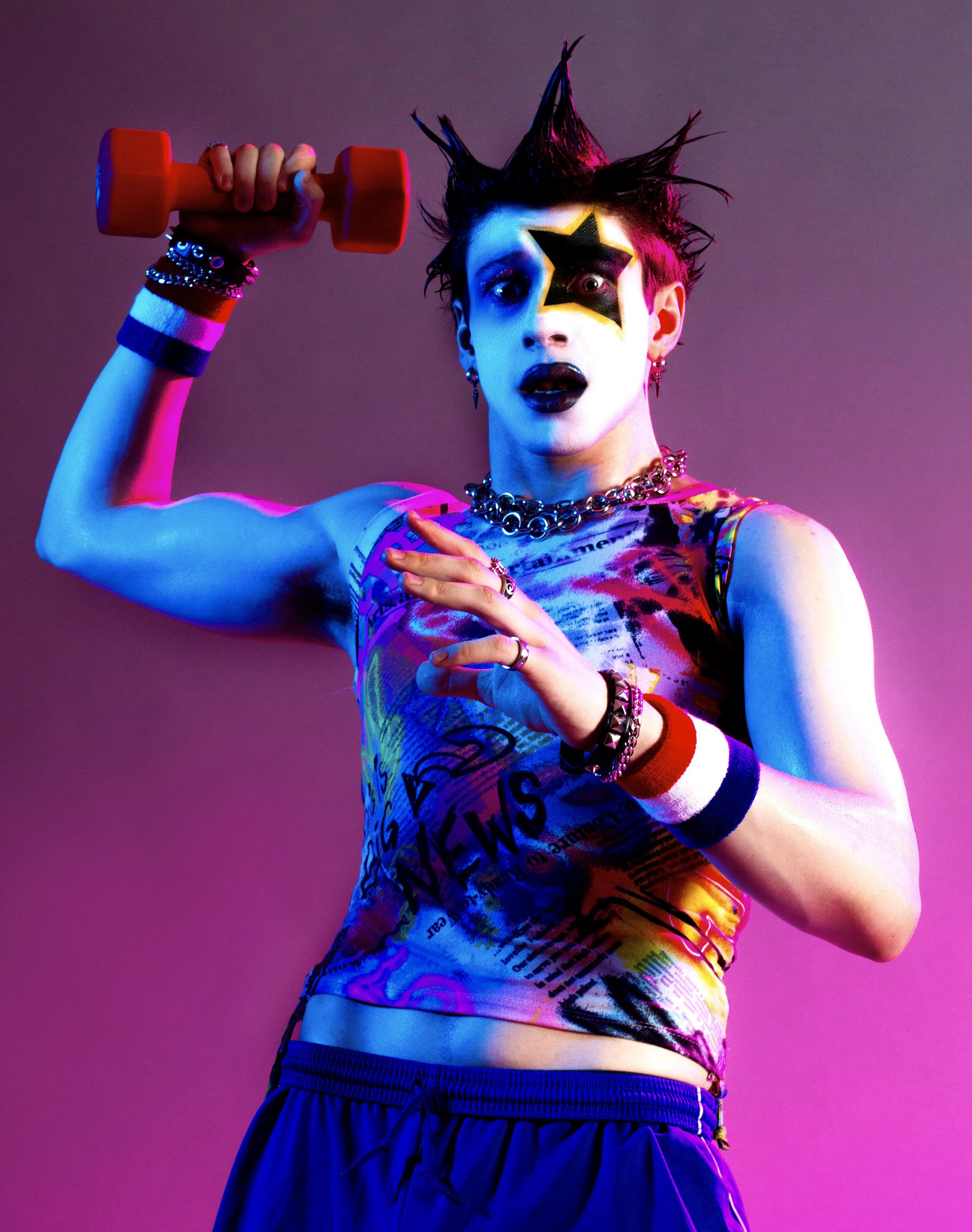 PHOTOGRAPHY BY: MICHAEL LANCIA
PHOTOGRAPHY BY: MICHAEL LANCIA

Every year, millions of Penn State fans drive to Happy Valley to see the football team take the field. For four months out of the year, fans cheer every weekend inside Beaver Stadium watching a large display of showmanship in the name of “athleticism.” However, there is a group of unsung heroes — those with sparkly uniforms — on the sidelines that many adore. Dancers have always caused a debate as to whether to classify the dance community as a sport or an art form. Dance not only evokes emotion through the actions portrayed but also the pictures and storytelling which allows us to become vulnerable and root for something. As dance has grown into modern competition dance, the sport is now moving right along with the evolving criteria of athletics.
Why do spirit teams, with the work they put into their craft, only get to showcase their work competitively once a year? The Universal Dance Association (UDA) competition symbolizes the hard work — blood, sweat and tears — that is left on the dance floor by the spirit teams. Owned by Varsity Sports, UDA is a dance competition and dance camp. Starting in 1980, the competition has held the most competitive dancers from high school to college each year at the Walt Disney
ESPN Wide World of Sports Complex.
“Balancing classes, UDA practice and game day dances can be hard at times, but we always make it work because we love what we are doing,” Nikki Romano, third-year broadcast journalism student and Penn State Lionette, says. “I plan out my days carefully, making note of when/where certain things I need to get done so that I’m not stressed out and I feel organized and prepared as we have very busy schedules.”
Founded in 1995, the Lionettes have been the official dance team for Penn State by starting as a kickline and club, transitioning into a highly competitive and selective dance team. Not only does the team take the sidelines for all athletics on campus as one half of the spirit squad but they are also in constant preparation for UDA Nationals. Their hard work has paid off as they most recently earned third place in the D1A Poms category nationals, but their achievements are not always publicized on campus. “Unlike most traditional sports recognized by federal law, dance is judged subjectively. I believe that the reason dance is not represented on a federal level is because of the lack of direct quantitative scores from a source other than a person,” says third-year kinesiology
student Amanda Rambach. “Additionally, because dance can be performed outside of a competitive atmosphere, federal law may more strongly associate it with being an art form.”
To support the Penn State spirit teams, you can watch UDA Nationals, support all their fundraisers for THON and other activities or even just pay more attention on the field as they dance during game day. Small contributions like these help the teams feel supported. Rambach, Romano and O’Shea all believe that Penn State has the best fans in the country. “Keep doing what you’re doing! I can confidently speak for my team when I say that all the game-day support means the world to us,” says Abby O’Shea, a second-year finance major and Penn State Lionette. “When we run out on the field or when we start the kick line and hear the crowd screaming, it gives us chills.”
Athleticism can be beautiful and the work that the Lionettes showcase on game day weekends helps make Penn State special. The next time you watch the Lionettes rally into their kick line, cheer a little harder, clap a little louder and show support.
38
It’s not easy to talk about. It’s uncomfortable. The first time many young people learn about their friends’ financial situations comes during college. There comes an uneasy realization: everyone elses families had very different conversations about money than yours.
Some students spend long hours working after class and through the precious weekends, and some of their classmates spend those weekends at restaurants and bars where their peers serve them dollar vodka sodas and pizza slices. Some students work to start paying off debt and support themselves. Others work to buy their groceries, pay rent or save for postgraduation. Others may work for extra spending money. Each student has a different relationship with employment, but these experiences can create division, especially when that division is difficult to talk about.
In a study on the effects of employment on college students’ academic performance, Avery Davis from Johns Hopkins University found that “‘Traditional’ undergraduate students begin seeing deleterious effects [in their academics] at 20 hours, which becomes even more severe for those working 28+ hours.” Katherine Maich, assistant
professor of labor and employment relations and women’s, gender and sexuality studies at Penn State, says that she sees this division firsthand. In her labor and employment relations courses, Maich asks students about their personal work experiences. “It does seem more and more that there are students who have not had a first experience of work,” Maich says. Even among this division, students can find that their work adds to their lives by creating purpose. Students working during college — and working even before college — can help them build their bank accounts and build character. According to the Cambridge Dictionary, “character-building” means, “helping to make someone emotionally stronger, more independent and better at dealing with problems.” Many first employment opportunities for young people are in food service or retail where they are exposed to customer service — and the benefits and frustrations that come with the public at large — for the first time. Madison Lavender, a second-year psychology student from New Jersey, works at BRGR in downtown State College. “It’s hard to balance school, work and my social life, but I’m happy that I have a job because I feel like
I need the extra money,” Lavender says. Despite the difficult balancing act, Lavender recommends that students take up a job because of the valuable experiences they can gain from interacting with the public.
“I feel like everyone needs to work in a restaurant to gain that experience,” she says. “My mom served her whole life, and she told me that ‘you need to work in the restaurant industry to gain a different perspective.’” Kate Schroeder, a 2022 alumna of media studies and comparative literature, worked at HiWay Pizza Pub during her time at Penn State. She got the job to pay credit card and car insurance bills, but she also worked in restaurants during high school and says she missed the environment. “Restaurant work is the best way to make the most money in the shortest time, which is what a lot of students need,” she says. “It can also be a good way to meet new people and be social, so there’s no downside in my opinion.” “I truly think working in the service industry is extremely important for young people,” Schroeder says. “It teaches teamwork with all kinds of people, the importance of clear communication, adaptability and learning on the fly.”
39

PHOTOGRAPHY BY:
40
SHANA ANDREWS
WRITTEN
BY GINGER LYONS
Veronica Zelner isn’t afraid to ask the waitress when the food will be ready with a polite smile, tacking on “please” and “thank you” before and after. She isn’t afraid to hand out business cards to girls she has never met before on campus that read “Hi, DM me” with a winky face. She isn’t afraid to strike a pose in a dark green rhinestone-encrusted bikini on a stage in front of dozens of people. She is the Blonde Unit.
Veronica grew up in Marco Island, Florida, where she tried every sport –– and didn’t enjoy any of them. Instead, she found her place in theater, where her “louder than life” and girlygirl personality fit in best. At 13, Veronica moved from Florida to New Jersey when her mom was diagnosed with cancer and needed better medical care. Her mom first moved out by herself while Veronica was still in school, leading her stepfather to take a stronger role for the family. Just about two years after their move, her mom became cancer-free. In New Jersey, Veronica continued to attend theater camps, experience the explosion of social media and idolize the personalities she saw growing up on YouTube, like Jenna Marbles. In high school, Veronica still tried to find a sport for herself, even after she began drifting away from the theater crowd.
“Nothing seemed to fit me, but I always had this just drive for fitness and a want to be connected to that community, but I didn’t know how,” she says. In 2020, after months of painting and “doing nothing,” Veronica decided to start pursuing the drive she felt toward fitness during her freshman year of college at Penn State Altoona. “I want to be able to create something for myself that will last for the rest of my life,” Veronica says.
“Yeah, you’ll see me around here a lot.” While she always has seen herself as confident in personality, Veronica’s attitude toward her physical appearance didn’t reflect that confidence –– and she wanted to change that. She switched her eating habits from a regular diet of Goldfish that she picked up during the pandemic to eating clean and organic. A few months later, Veronica saw a difference — and so did her growing of Instagram followers. Documenting her new lifestyle and answering questions on her Instagram story led Veronica to connect with a Rutgers University kinesiology student who was interested in making her a weightlifting plan. She signed up for Planet Fitness, followed her new plan and continued to post her progress. Her followers, whether they were past classmates or friends of friends, felt encouraged by her, and their support motivated Veronica on her journey.
“Girls that I went to high school with that I
would envy based on the way they did a sport or the way that they looked were reaching out to me and being like ‘Hey, can you send me your workout plan?,’” she says with a reminiscent grin. At Altoona, Veronica found a group that inspired her as she explored the fitness world. The summer after freshman year, she continued to push herself, working hard in the gym and posting her progress on social media. “I acted like I was an influencer,” she says.
During the fall of her sophomore year in 2021, Veronica joined her first bodybuilding gym. It was dirty — smut plastered on the walls and dim lights –– but she loved the feeling that she was “for real” about bodybuilding. “I remember coming up to the front desk guy like, ‘Yeah, you’ll see me around here a lot,’” she says. As she began to gain more of a following on her social media, Veronica asked her private fitness story followers what she should name her new fitness Instagram. Luckily, a past classmate provided the perfect name to emulate Veronica’s personality in and out of the gym: the Blonde Unit.
The Blonde Unit became Veronica’s online diary for all things fitness reflecting the young girl she used to be who dreamed of becoming a YouTube sensation. She confidently posted workouts, fitness videos and personal bests to her new, revamped “fit-stagram.” While Veronica was set on her new workout routine, a photo on Instagram caught her eye and altered her goals entirely –– a photo of a “shredded” female bodybuilder in a sparkly bikini. “How do I do that?” she thought. As a glamor-loving girl who wore a sparkly tiara on every birthday through her teen years, Veronica saw the rhinestone-plastered bikini and was sold.
“I saw that, and I went ‘Yep, I could do it. 100%,’” says Veronica. “Which now, two years later, looking back on it, is absolutely fucking absurd, but that has been every single thing I’ve ever accomplished.”
Veronica felt entranced by the sport. Becoming a true bodybuilder had now evolved into an achievement that she fiercely desired. Perhaps her outlook was in part from her attitude of “delusional confidence,” in her own words, but she had the discipline and drive to take on this new era of her life led by her goals. The summer before her junior year in 2022, when she would attend University Park, Veronica hired a professional coach and joined a bodybuilding gym in her hometown. While, at first, the new gym was intimidating, she quickly befriended Liv Odrzywolska, a more experienced bodybuilder, after she complimented Veronica’s outfit. The two friends have stuck together throughout Veronica’s
entire bodybuilding journey.
Alongside her new coach and friend, Veronica learned the advanced knowledge that went into bodybuilding — including nutrition, how to follow a plan and ultimately, how her body functions when building muscle. After getting a feel for bodybuilding, in November Veronica decided to start her 22-week prep, a period of time dedicated to an extremely regimented fitness and nutrition schedule, for her first competition in February. However, her parents were hesitant about her competing and worried that she would come to them for money to fund her prep. While they financially supported her through school, they were not funding her bodybuilding — and the expenses that came with it. “At the end of the conversation, my parents said, ‘It’s like you’re allergic to money, Veronica,’” she says. “That shit lit a fire under my ass.”
“I did my first one, and she looked fucking bomb.” While the thought of proving her parents wrong tossed and turned in her head, Veronica eventually found a way to fund her upcoming prep: spray tans. It was perfect –– she had been getting spray tans since she was 14 years old and had been the designated “self-tanner” girl at her previous job at Ulta. Doubts that this could be just a “silly idea” rolled around in her head, but was it really that silly? In her studio apartment, Veronica balanced classes, set up her Facebook Marketplace spray tan equipment and began her bodybuilding prep. She surfed Reddit pages to discover leaked cosmetology school guides to read up on, spray tan experts’ Quizlets and instructional YouTube videos –– ensuring that she understood how to professionally spray. After practicing her lines on a white tarp that she bought from Goodwill, she felt ready for her first client. “I did my first one, and she looked fucking bomb,” Veronica says, though at the time, she felt nervous and was acting on that same “delusional confidence.” From there, Veronica built a new social media empire, this one being titled Tan Luxe. She put up some pictures of her first client on Instagram, asked her Snapchat friends to get a spray tan in exchange for promotional photos and printed out business cards, watching as her “silly idea” came to fruition.
By the time the 2023 spring semester rolled around, Tan Luxe was booming. Veronica tanned the Lionnettes, the Penn State Cheer Team and sororities, as well as doing many philanthropy partnerships with other campus organizations. The business prospered, and she even introduced hair tinsel services to her clients. “You’ll never really understand it unless you’re in it.” Veronica was heavily in prep for her nexr two upcoming
41
competitions. Within the 22 weeks, she watched her body undergo rapid change, and she became extremely regimented with what she consumed. “Each week, you’re stepping into a new version of yourself,” she says. “It’s incredible. It’s seriously like a metamorphosis.”
Veronica felt akin to a caterpillar transforming into a butterfly as she saw new lines and veins transform her body. The transformation took discipline, struggle and sacrifice, though. Her friends went out to the bars at night and stayed out until the early morning while she was trying to find an open gym to do her cardio. She stayed at school through the holidays and continued to prep, sacrificing large family feasts for her quiet State College apartment, cluttered with spray tan equipment instead of holiday decorations. “When you’re in that prep phase, nothing else matters because you’re just so excited for your goal,” she says. “You’ll never understand it unless you’re in it.” Throughout prep, Veronica worked with local members of the International Federation of Bodybuilding and Fitness Professional League (IFBB pros). While she was competing in the Organization of Competitive Bodybuilders (OCB), an all-natural federation that requires a drug test and a polygraph before competing, she admired all of the women who competed in the National Physique Committee’s (NPC) competitions — the largest bodybuilding organization in the United States where a competitor like Veronica could become a professional.
Veronica chose to compete in the bikini category for both the shows she was prepping for, striving for an “X” body shape fuller shoulders, glutes, quads, and hamstrings as well as muscular, but not overly toned, abs. The judges in the bikini category look for balance in the physique. The women strike a pose in clear high heels, fluorescent bikinis hand-jeweled with glistening rhinestones and sparkling jewelry. They are painted with a bronze tan to emphasize every line and muscle. Lashes are pasted onto their eyes, glam is fully done and hair full and voluminous. The women who stand on this stage look like action figures and Barbie dolls melted into one. “[Liv] was the one who really introduced me to bodybuilding seriously because she is very deep into this as well. She bought me my jewelry for my show,” Veronica says.
Inspired by one of her all-time favorite bodybuilders, Ashley Kaltwasser, a three-time winner of Ms. Bikini Olympia, Veronica selected a nice dark green bikini, hoping the color would bring her luck. “It’s really emotional and special because you dedicate yourself so much to be able to present your physique in such a special way,” she says. “To some people, it is just literally a
bikini, but to the women in bodybuilding, it’s your world.” On Feb. 28, 2023, Veronica competed in her first show in Atlantic City, New Jersey. She arrived at the hotel, passed her lie detector test and tried to stay calm. Liv was there as her “stage mom,” carrying Veronica’s backpack for her and helping her navigate all the emotions she was feeling. “Even though it was her first show, she didn’t show many nerves and was her normal bubbly self,” Liv says. “I just remember her being excited to get up there and do her thing.” While Veronica’s face of confidence was shining through, she felt jittery about going up on stage for the first time. “It’s hard to relax,” Veronica says. “When you know the thing that you’ve been working on for the last five months is about to happen tomorrow.” Supporters from various points in Veronica’s life showed up for her in Atlantic City: her siblings, a friend from her Birthright trip to Israel, her fellow bodybuilders and her parents who, despite their financial concerns, cheered her on through prep and her shows. However, she says that her competitive strength came from her inner soul and her box of competition essentials: her special bikini, her other show gear and the handwritten note from herself expressing how proud she was for making it to this moment.
The morning of the show, Veronica got her hair, makeup and tan done a highly saturated shade closer to paint than the tan she uses for Tan Luxe. At the same time, she entered her last day of “peak week,” the final week before the show when training starts to focus more on making the body look fuller. “They actually have to manipulate your body with water, food and candy,” she says. Every few hours, she would send her coach a photo over text of herself posing, and he would tell her what to eat or drink to bolster the appearance of her muscles, whether it be a few ounces of water or another Reese’s Peanut Butter Cup. After writing a paper for class and responding to Tan Luxe’s clients in her hotel room, it was finally time for the show to start. In the swarm of strong, muscular women, Veronica was looking to make friends by telling each competitor how beautiful they all looked and how proud she was of all of them. “That really mattered to me, to go in with a really positive mindset and attitude toward everything because, at the end of the day, I knew that if I was at least kind, that’s all that mattered to me,” she says. The line of women walked out onto the stage and began their posing. Veronica, in her full glam and enormous high heels, felt what everyone else on stage was feeling the glaring lights, tension in her smile, the difficulty in trying not to sweat. They all held their poses while the judges moved them into different orders, comparing each physique to the next.
During the next round of individuals, each woman displayed their style of posing, some more sexy, others more simple, while Veronica herself went for bubbly and girly, with hair flips and bright smiles, staying true to her off-stage personality. “It’s self-expression in a wonderful way,” she says. Veronica placed third overall, an accomplishment she was proud of, but also made her want to strive for even better. A month after her first show, she entered her second competition in Bloomfield, New Jersey, where she placed second in her class and third overall, finishing off her season of competing. “You go from being a Barbie to just being a regular girl.”
After her shows, Veronica switched coaches and began to learn all new elements of bodybuilding like tempo pace for training, blood glucose tracking — even tracking her stool –– and what each measure means for her body. This postprep created a new challenge for Veronica as she had to begin reverse dieting and increasing her caloric intake. “Without having the goal of a show in mind, it’s really hard to stick to your goals. I also turned 21 at the same time, and it became the perfect storm,” she says.
Veronica had difficulty seeing her body change, missing the popping veins, defined muscles and leanness she had worked for. She began the difficult journey of learning to love her body outside of prep. “My body image got extremely skewed,” she says.
The image that she created with Tan Luxe helped her during this time. She had always advocated for body image positivity and strived to make her clients feel beautiful, no matter what body type they had –– why couldn’t she do the same for herself? “You go from being a Barbie to just being a regular girl,” she says. After a summer of learning self-love through therapy and personal growth, Veronica switched to lifestyle training –– still training and following a fitness regimen but also taking rest days and enjoying going out to eat with her friends. Veronica continues to grow her Tan Luxe business right from her State College apartment, with plans to move her enterprise to Tampa, Florida, at the end of the summer. In the meantime, the political science major with dreams of going to law school is finishing up her senior year, having collected two bodybuilding medals, a living room full of spray tan equipment and the knowledge that whatever comes next, she will figure out –– even as she learns how to DJ, adding another hobby to her collection. As for bodybuilding, she sees herself competing again in the future, but for now, her bikini waits in her closet for the next time she poses on stage.
42
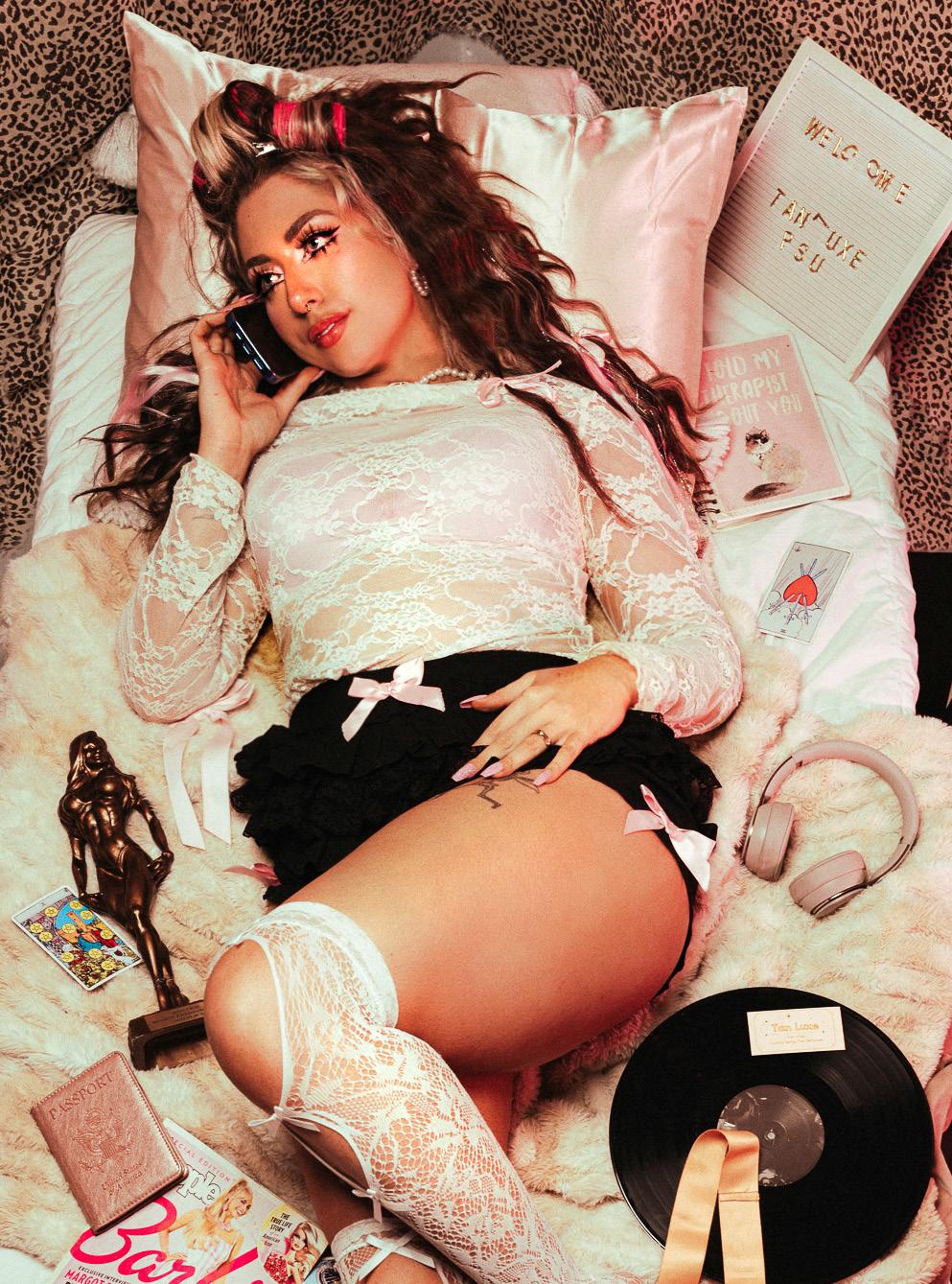

CLOTHES FROM: PLATOS CLOSET @platosclosetstatecollegepa
WRITTEN
BY VANESSA HOHNER
In the same way that hair holds memories, so do our couches. The Sunday scaries, movie nights and therapy sessions are pinnacle times and precious moments in our college years. We all watch our college couch go through the seasons the same way we do. Furniture is more than just pieces of wood and cushions bound together. Instead, our furniture savors memories and times of nostalgia to remember forever. Rather than just a place to sit, it serves as a medium to bring those we love most together and experience sentiments as one. What’s so special about a couch to college students, anyway? How can one possibly be bonded to an inanimate object?
Brooke, Nicole, Izzy and Laura are all third-years who have been roommates ever since sophomore year. They live at The Diplomat in downtown State College and their apartment is more than just four walls and a place to come back to after class but rather a home with character and life. Sacred memories and bonds are intertwined among the cushions and pillows. Brooke Abraham, a third-year nutritional science and dietetics student, loves her gray sectional sofa that’s hosted many movie nights and hungover mornings with her roommates. Couch naps are just something a bed cannot offer.
“My 21st birthday hangover stays at number one. I spent an entire day on the couch and quite literally could not move. Our couch was my savior that day,” says Abraham. Not only is it a place to ease the noise of a hangover but also their couch becomes the core for their weekly pyramid tradition as Brooke and her roommates gather on their sofa with teeth chattering and anticipation of who will be at the bottom. “There’s nothing
better than movie nights, weekly pyramids and eating Taco Bell on our couch with our friends. We become literal couch potatoes for the night and time just freezes. We’re like magnets to that thing,” says Abraham. While most students live with one or two others, Reese Hayes has twelve roommates in a three-story house downtown. What makes this group unique in comparison to a normal living situation is that their house is made up of one big friend group that’s a mix of boys and girls. Each set of friends has their own floor as well as their own couch where memories are burrowed through naps and movie nights. They have their fair share of recollections on not one but three couches. For these roomies, trivia night is a staple for the “Brady Bunch.” Heated debates and exciting victories bring them together on their beloved sofa.
Hayes, a third-year political science and criminology student, recalls his favorite moments when procrastination wins the battle but loses the war. “When we all get back from class with food we end up on the couch in Noah’s room,” says Hayes. “Somehow three hours will go by and we have just been goofing around instead of doing the homework that is due at 11:59 p.m.” Not only do long naps and tired feet get lost in their long and worn-out sofa, but so do their valuable items. Missing remotes and phones cause cushions to be flipped over and shouts of “Where is the remote?” to get thrown around the room.
“It really becomes a full-blown argument whenever we can’t find something on the couch, accusations get thrown around. But, once it is found a sigh of relief wavers, and we all get right
back on the couch,” says PSU student Reese Hayes.
Not many, if any, sororities get the luxury of having a house here at Penn State. However, one sorority was able to obtain a house to defy the norm. With only fraternities being allowed to have houses, this sorority house stands out on Penn State’s self-proclaimed “frat row.” At the center of the sorority house, as well as the girls’ hearts, sits the renowned couch that fills up their living room with memories and reminisces. The navy blue, u-shaped couch certainly stands out in a house with 21 roommates. Grace O’Shea, a third-year early childhood and elementary education student, recalls the true definition of a family movie night when her family came up to visit the house on one weekend last semester.
“It has at least eight sections. It could fit an army basically. My family came to visit and we had a movie night watching ‘Pitch Perfect’ with my friends. We ate a gross amount of snacks together, and it was perfect,” says O’Shea. A fellow roommate Melanie Meehan, a third-year actuarial science student, is reminded of the bittersweet occasions when the couch served as cushions of comfort. Meehan makes it clear where “loveseats” get their name.
“One of the worst moments was saying goodbye to one of our roommates Ariella who is currently studying abroad. Goodbyes suck, and it certainly was a very sentimental farewell,” says Meehan. The art of a couch holds a purpose that acquits us to gather with many. Couches are where armrests act as pillows, stuffed-shaped squares allow our tired bodies to rest and priceless memories leave impressions on the cushions as well as our lives.
45

46

Bright lights, loud music, and sweating bodies rubbing against yours. Imagine the night air thick with euphoric energy as bodies move in a synchronized frenzy, lost in the music. The thrill of being in the club stays with you ringing in your ears even after you leave. All you can think about is when you will be back. This is the life you are destined to have. The disco becomes your home until it doesn’t.
Mascara stays on for six days at a time — last night’s makeup never comes off. Waking up in your club clothes from the night before becomes a ritual. You start to get the look of disappointment from your friends and family, questioning what you are choosing to do with your freedom.
Welcome to the “party phase.” This typically refers to a period in someone’s life where they actively engage in the nightlife regularly. During this phase, individuals might explore different social scenes, attend events regularly and prioritize a more vibrant social life. The party phase is characterized by a sense of freedom, exploration and a desire to embrace the enjoyment of social activities. When you enter your “party phase” you almost never expect to come out. For all of your life, you fantasized about turning 21 and being able to go to the bars and clubs.
“I used to feel pressured to go out as much as I possibly could to get the full ‘college experience,’ and felt like I always had to go to parties for other people,” Emily Hold, a fourthyear Penn State student, says. The effects of social validation enhance the party phase the most. Prior to hitting your peak breaking point of loving life in the bars and clubs, you are almost forced to constantly uphold this vibrant and outgoing lifestyle until you cannot live without it. “Way back when I was freshly 21, I was most definitely in my party phase. I found myself wanting to go out multiple nights a week, which ultimately left me feeling most drained during the day,” says Gabbie Mirza, a fourth-year student at Penn State.
way to a period of self-reflection and personal growth. “I found myself having low energy, not eating healthy foods and having no motivation to do anything but party,” Mirza says.
The constant late nights may lead to feelings of exhaustion, unhealthy habits and a lack of motivation in other aspects of life. Recognizing these negative effects from partying is a crucial step in self-awareness. Many people find that, as they grow older, priorities shift toward a more balanced lifestyle that often includes both social enjoyment and personal well-being. It’s natural to reassess and adjust your lifestyle to align with your evolving needs and goals.
The allure of going out multiple nights a week can be exciting, almost like you can forget about the reality of your everyday life and can only allow yourself to remember what goes on in your nights. It seems perfect until your physical and mental health begins to become affected. People go through all different phases in life, and the transition from one phase to another can bring about various changes. When the major partying phase comes to an end, individuals will often experience a shift in priorities and lifestyle. The carefree and social nature of the party scene gives
Realizing that there needs to be a sense of balance between the party lifestyle and the real world starts the first step to maturing. A night in may seem so small but can be the best thing for your mental and physical health. “Now that I am of age, I’ve realized that while going out can be fun, a night in watching a movie is even better,” Mirza says. Go through your party phase, wear that makeup for days on end, don’t wash off the glitter from Taylor Swift night –– just know that it may not last forever. While the constant go of partying may be fun on its own, you can also find yourself and learn how to prioritize yourself, not the disco
48
“If art is how we decorate space, then music is how we decorate time.” — Jean-Micheal Basquait
In the grand tapestry of human existence, time unfolds befor1e us like an endless canvas waiting to be adorned. For a lot of us, what’s better to do than play a melody? On the surface, seeing music as a “decoration” may seem rather cryptic, but most of us carry that quote with us every day. In the chaos of all of our daily lives, it seems as though there can only ever be silence or noise. However, for so many people, it is music that accompanies their every move in life. The idea of music being a companion, something that “fills the gaps” in time, resonates deeply, as music has a profound impact on a life. Whether it’s a tool to tune out anything else while working, finding motivation in an upbeat tempo at the gym or seeking solace in a song that matches our mood during a quiet evening, music serves as the brush `11 that colors our “temporal canvas.”
State, says. “Sometimes, I control how I feel and who I am through it, sometimes it controls me.” An attachment to music goes beyond mere enjoyment; it’s a psychological phenomenon. Music has the power to influence our emotions, productivity and even memory. The rhythms and melodies we choose to surround ourselves with become the palette with which we paint the moments of our lives.
an adversary to ward off. The idea of spending moments in quiet contemplation has become foreign, replaced by the desire for a perpetual soundtrack to our lives. Music occupies the gaps, erasing the void that silence can sometimes create.
The student drowning in textbooks finds calmness and a steady mind in the harmonies that play through their headphones. The professional navigates a busy cityscape, each step synchronized with the rhythm of their chosen playlist. Music becomes a temporal anchor, helping us navigate the ebb and flow of time with a sense of purpose and emotion.“If I am listening to music when I’m studying, my textbook isn’t all that’s in front of me. It just helps take my mind off that stress that comes with just … being a student,” Alisha Imtiaz, third-year biology student, says.
At the end of every year, as things like “Spotify Wrapped” come out, our tendency to start correlating each other’s lives, personalities, lifestyles and even more through our tastes in music becomes apparent. “I feel like I see music as an extension of myself sometimes,” Brent Freeman, a third-year student at Penn
Given everything else, why exactly do so many of us feel the need for constant auditory companionship? Silence, it seems, has become
“When I’m focused on the music I’m listening to, I do not really have to think about anything else. It helps me regulate my thoughts sometimes when I’m overwhelmed,” says Andrew Kim, a fourth-year student. Perhaps music serves as a golden shield, protecting us from the potential emptiness that silence can bring. The rhythmic patterns and melodies provide a distraction, a pleasant diversion that keeps our minds engaged. As we explore the intricacies of our relationship with music, it’s essential to recognize its therapeutic role. In an increasingly chaotic world, where time is often a precious commodity, music becomes a safe haven. It is not merely a background noise but a personalized soundtrack that transforms our mundane moments into memorable experiences. Our temporal canvas is a rich tapestry of moments, woven together by the melodies that shape our experiences. Music transcends the very boundaries of time, offering us a means to express, connect, and navigate the intricate dance of life. So, the next time you press play on your favorite song, you are not just listening to music; you are adding another stroke to the masterpiece of your existence.
49




Hate Speech. Cyberbullying. Scams. Violence. Pornography. All one click away for anyone with Internet access.
Fun fact: According to Statista, 84% of parents in the U.S. in 2021 monitored their child’s Internet activity. But, back when Gen-Z was growing up in 2012, only half of parents used any type of Internet monitoring or parental controls. The phrase “unrestricted Internet access” has long inserted itself into memes across the Internet, poking fun at the staggering and ill-suited online content college students endured growing up. While it’s easy to make fun of that now, there was some wildly inappropriate content that current college students saw at a young age.
The real question is — how did it impact a whole generation? From having uncomfortable Omegle chats, descending into YouTube rabbit holes, being part of Kik group chats with strangers and dressing our characters as trashy as possible on MovieStarPlanet, how did the premature exposure to unfiltered mature content affect development?
If your parents or guardians were welleducated about the extent of online information, social platforms and ways to control their child’s access to that, then congratulations! For many, that wasn’t the case. But, can we blame parents for not controlling our Internet activity? They were learning the ropes of the Internet, too, unsure of what to think and feel about this transition to
online entertainment and communication. “Ask yourself, ‘Is this the best way to have a conversation?’ What will you miss out on? So much of communication is body language, and we capture some of that through video chats, but it’s not a replacement,’’ says Max Crowley, professor of human development and family studies and public policy. The transition from in-person to online communication also meant that children were picking up ideas and speech patterns from the online world. Whether it was from friends over text or from a Musical.ly starturned-YouTuber, kids began to learn about the “adult” topics of life through a screen.
“There’s no right way to learn about the world. There’s no right way to learn about hate, sex, drugs or any of those things. But, there are definitely wrong ways,” says Crowley. In the bestcase scenario, kids will learn about these subjects from a trusted adult, but again, that’s not always the case. “The important thing when you’re an adult is to challenge your assumptions around hate speech, sexuality and sexual behavior about what’s okay and what’s not,” Crowley says.
Unrestricted Internet access may have exposed kids to the wrong things at the wrong times. Because of this, there has been a collective nostalgia for this troubling topic — a feeling of “Wow, I can’t believe that happened!” type of sentiment through memes on social media. “It’s actually a really good sign that we’re laughing

about it. Humor is cathartic — it allows us to say ‘this bad thing happened, but I’m okay, and I can laugh about it,’” says Crowley. “I think it’s a good sign that we’re learning, laughing and recognizing that we need to do things differently and better.”
This generation, for the most part, seems to have decided to do something about their past experiences with Internet content. If you were exposed to inappropriate language and slurs, discriminatory propaganda, predatory behavior, misrepresentations of sexual health and acts, cyberbullying and more at an early age, then you have become a voice to challenge those ideas. Instead of Gen-Z becoming desensitized to poor behavior, a majority of them decided to hold people accountable for it all. “I think that your generation has really recognized and called out hate speech in a public way, stating that ‘this is not okay,’” says Crowley.
At the end of the day, it’s important to challenge any harmful ideas we learned about when we were growing up. It’s safe to say that Gen-Z has a unique perspective on parenting alongside the depths of the Internet, and many of us have learned the ropes of it first-hand. Today, we can continue to bring our insight and knowledge about unrestricted Internet access to light for the benefit of generations to come.
51
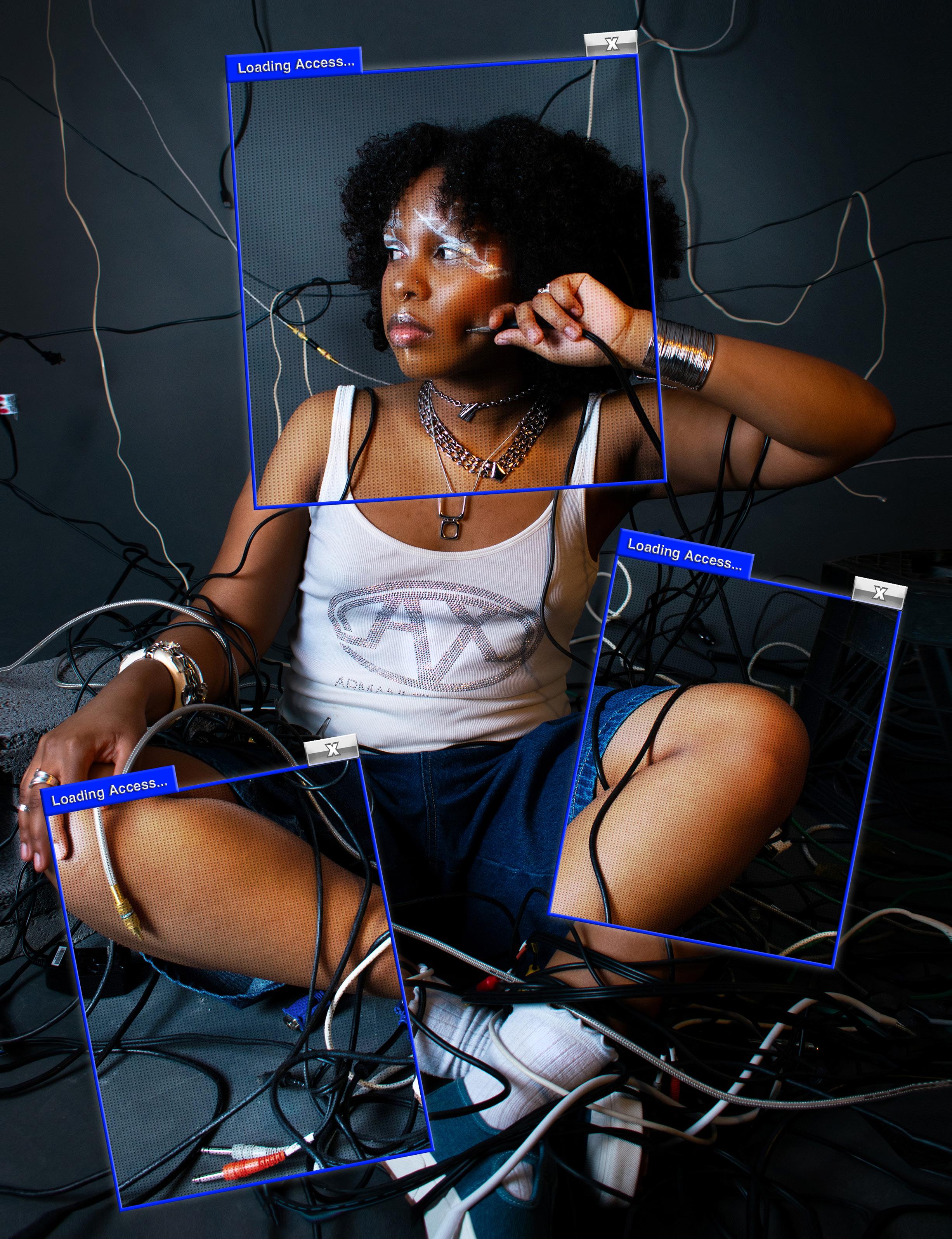
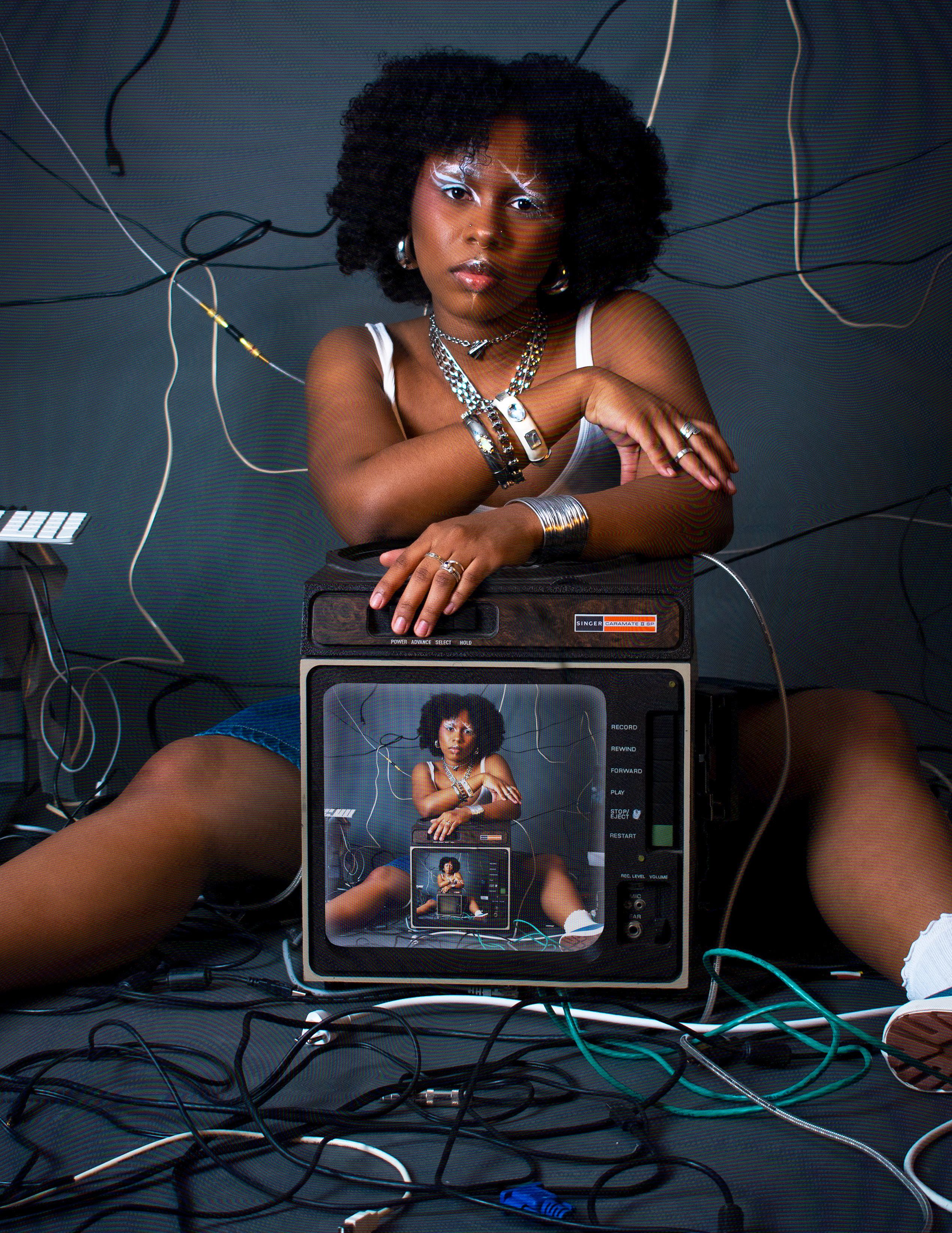
@platosclosetstatecollegepa PHOTOGRAPHY BY: ZOE EDDY
JEWELRY FROM: PLATOS CLOSET
The Internet is your best friend. It listens to you weep, listens to you shout, listens to you in your happiest moments. Right there, in your hand, is the Internet. A lifeline.
You want to give your significant other a gift, so you buy them their favorite Pokémon stuffed animal from Amazon. You want to find the nearest ice cream shop, so you search “best ice cream shops near me” and read reviews from people you will never know, and yet, trust them wholeheartedly. You want to fix your style, your wardrobe, your makeup, your whole life, so you search “lifestyle aesthetic” on Pinterest. You pin pictures of people who are complete strangers. You look for who you want to be on the Internet.
to have that physical evidence that you are going through it together. You text all night. You don’t even cry. You fall asleep to the sound of waves, and the waves crashing into each other again and again play from your phone all throughout the night.

Google, I’m feeling lonely. But you’re there, aren’t you? Can you offer me some comfort? Your parents are fighting outside your door, and you drown out the anger by listening to some music on Spotify and scrolling fervently on your phone to escape the yelling –– the yelling that seems so distant now. You text your sister, and even though you share a wall, you don’t dare leave your room because it is much more comforting
You are not sure what you would do without the Internet. To disconnect from the Internet would be severing a crucial connection. A connection to the entire world, with people exactly like you. You can type anything and it is almost like your entire brain splattered onto the screen.
At the same time, you have a primal desire to sever the connection from the screen.
Even when you try to put a time limit on your phone, you can’t help but press “remind me later.”
There are several explanations for this, but none that can solve the issue. There is a dream that one day, the connection to the Internet will be severed.
That you can go outside and not think about your phone or what is on your phone. The only time you can imagine disconnecting from your phone is when you are in an undisclosed, faraway place that is removed from what reality currently is.
Martin Marinos, an assistant professor in communications at Penn State who specializes in global mass communications, explains that this phenomenon by saying that adolescents, teenagers and young adults growing up in this age cannot avoid the Internet — it is a new part of life. It is here to stay. “Material and technology is ubiquitous,” Marinos says. “It’s constant. You cannot detach, and you need it to be a member of society. It was possible 20 years ago, but not any longer.”
The rampant desire to disconnect from the Internet will likely always itch your brain. It’s wrong, fundamentally. It’s not how you were supposed to live your life. It is certainly not how your parents imagined technology to be. But –– who would you be without the Internet? It is hard to imagine that you would have the same interests, knowledge and hobbies. This is who you are, though. And maybe you would never want to sever that connection. The Internet is the enemy, the hero, the problem, the best. An intimate connection with a screen is just that – a connection. It’s not physical. It may not even be real, but as you read this likely on your phone or laptop, it is because you are reading this on the Internet. Pretty meta, right?
54

55
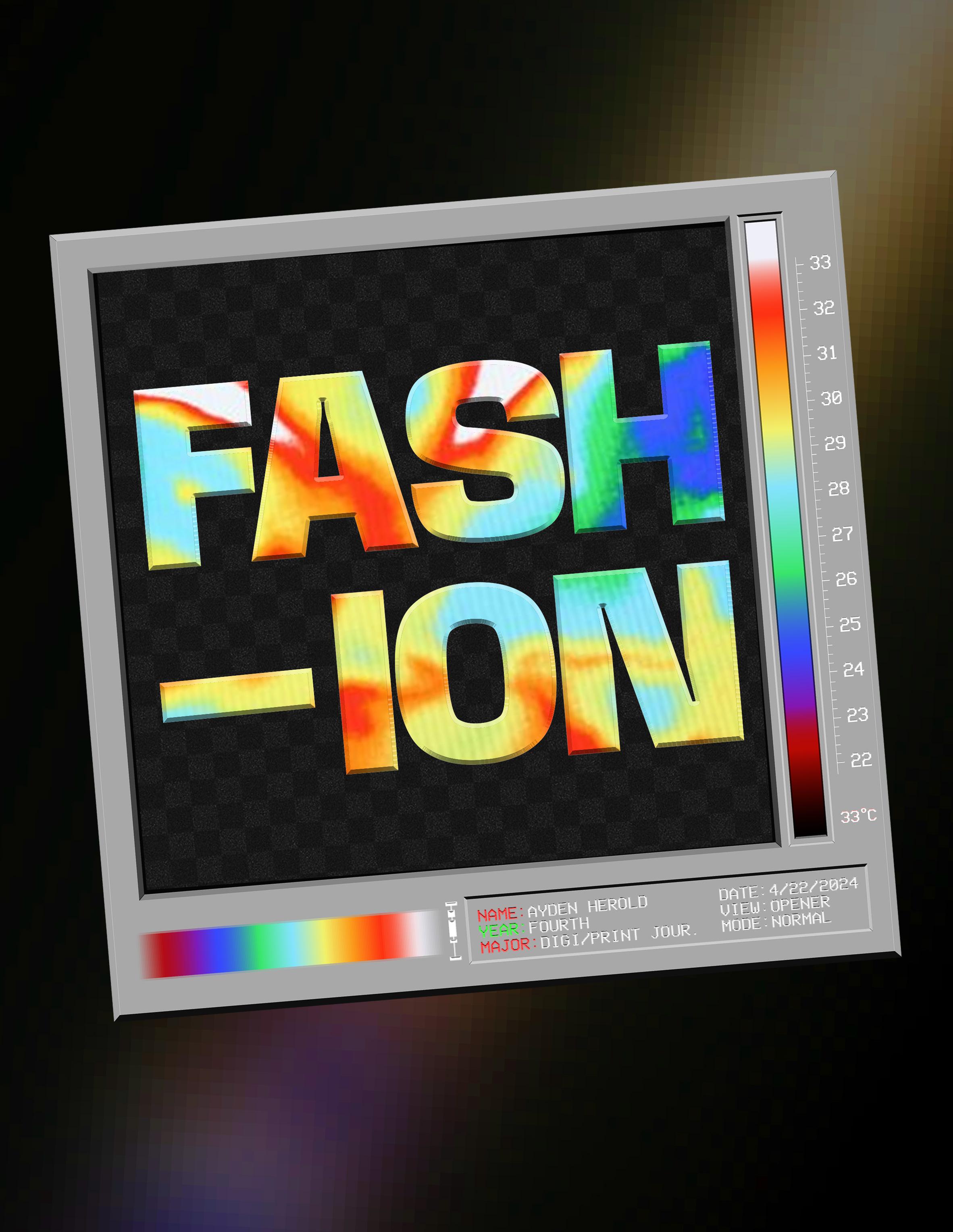
56

Many worry about what to wear. No matter your age or gender, deciding on what to wear can be a struggle for any event –– whether a dinner, night out or day with friends.
In a world where casual attire seems to dominate, the term “dress to impress” has almost been pushed aside. However, let’s challenge this fashion “faux pas” and start to embrace a new idea: you can never really be overdressed. You are just outdressing everyone else. The saying “dress for success” really does hold value in all aspects and times of your life. Whether it’s attending a social gathering, business meeting or casual outing, the way you present yourself speaks volumes in both your personality and professionalism. First impressions are formed within seconds, and your attire and outfits play a crucial role in shaping our perceptions.
“Being overdressed is subjective. Each person has their own comfort level with what they want to wear and their unique definition of what they consider ‘overdressed,” Jenna Mitarotonda, a Marist College fashion school graduate, says. Mitarotonda focused on the point that everyone can show their own personality and style through their fashion, and you can’t judge someone on being “overdressed.” “If someone is overdressed,
maybe their style might just be different, and sometimes maybe even better, causing them to outdress everyone else,” she says.
By choosing to elevate your style choices and dress more formally than an occasion may require, you portray a great sense of self-respect, confidence and attention to detail in both yourself and your style. People are naturally drawn to those who give off a sense of elegance, and by being the best-dressed person in the room, you capture attention almost instantly. “Honestly overdressing, or, outdressing, is highly inspiring. It gives fashion ideas to people who maybe are not as into it as others,” Gaby Amorosi, a Marist College fashion student, says.
Setting a standard in fashion means not conforming to any dress code. Outdressing is all about expressing your boundaries, comfort and style. Adding to an outfit can be just as simple as adding a blazer, wearing heels instead of sneakers or adding some extra jewelry. Plenty of people will think wearing a dress instead of jeans is excessive. In reality, that’s not being overdressed; you are simply just dressing to your comfort and style, which may just outdo others.
This idea doesn’t just apply to fancy events or a night out. The clothes that you wear to
class, around campus and in the dorms get looked at the most. Why not throw in the mix some fresh, new accessories to elevate it? Perhaps a colorful, printed scarf or a vintage hat will do the trick. Imagine this: you just spent almost your entire paycheck on a brand new going-out top. You come back for the spring semester after break to realize that your friends’ going-out outfits are starting to become more simple; however, your new top is far from that. You put it on to realize all your friends are dressed more simply. What are you going to do? Well, wear it!
The art of confidence is something that every individual needs to embrace. Every little thing goes into making a person feel confident: clothes, style, hair, attitude and more. Wearing clothes that you feel comfortable in and loving the way you look in them builds that confidence. So, who cares if you are better dressed than everyone else? Even if you’re wearing a cocktail dress to the bar when your friend is wearing sweats, if you’re both comfortable, that’s what matters. To most college students, standing out negatively can create pressure to fit in. But, who really cares? Wear what you look and feel good in. If your style is just simply better than others, then so be it.
58
WRITTEN BY VANESSA HOHNER
“Hey, can I borrow that shirt? You know, the one that’s pink and ties at the top?” It’s truly a forever unexplainable feeling, actually putting yourself in someone else’s shoes or, in this case, someone’s shirt. You poke your arms through the two sleeves, shimmy the base of the shirt down your stomach and walk towards the mirror.
Your head rises up as you look at your reflection, a small smirk rounds your face and you think to yourself: “This isn’t even my shirt, why does it look better on me than my own clothes?” The act of borrowing a friend’s top is one like no other. When we put someone else’s clothes on our body, we feel bonded — if not, glued — to it, like it’s meant to be on our skin.
This reveals the real basis for why other people’s clothes feel better on us than our clothes. Oftentimes, our clothes seem dull and tired. They tend to emulate a “been there done that” aura. The “air of otherness” captures our heart and makes a simple cloth cut into shapes and various different configurations so much more than something to cover our bare bodies. Clothes give off more than just warmth but an energy that makes us glow and shine from within. Synonymous with the concept of human desire and “wanting what we cannot have,” seeing a clothing item that makes us stop in our tracks and do a double-take enchants our minds. We immediately want that item to hug our body the same way it does on that person.
The saying “One man’s trash is another
man’s treasure,” is the very impetus behind the exchange of clothes. The frivolous and forgotten sweater at the bottom of your dresser drawer is viewed as the lustrous shirt on a mannequin in a display window to another.
we so shamelessly borrowed, it wouldn’t be the same. “My roommate has the cutest brown, mini cargo skirt with buttons on the side. I styled that with just a basic black top,” Foster says. “Even though the outside was kind of basic, I remember feeling so unique and a renewed sense of self. If I were to go out and buy it, I would lose that thrill of wearing hers.”

Rachel Foster, a second-year student majoring in health policy administration and a member of the Fashion Society of Penn State, depicts the ardor and the sensation of borrowing clothes.“When you borrow someone’s clothes, you feel reinvented,” says Foster. “We get bored of what we have, and it becomes displeasing to the eye after wearing it oh so many times. When we switch it up and wear your roommate’s shirt, it’s something fresh to look at.”
Foster enjoys expressing herself through her style of streetwear and making vintage clothes modern. Foster describes she loves to express her diverse fashion tastes based on different occasions. Therefore, her wardrobe has fallen victim to something borrowed. “My roommate often digs around in my going-out tops bin – she’s always in it looking for something,” says Foster. “She wears my black mini skirt from Edikted all the time. It’s super flattering on everyone, and because it’s a basic, she feels confident pairing a lot of her tops with my skirt.” Even if we buy the same shirt
“Hey, I almost forgot, I need to return that shirt to you.” Your insides want to keep it, but your outside knows you must return it to its respective owner. You go home and prod through your hamper until you pull out the top that’s layered under dozens of your garments. You throw the shirt in the laundry as you watch the water wash away the smell of the brief ownership you once had intertwined between the sleeves and seams.
Folding it tightly — you say goodbye to your borrowed friend and reluctantly hand it back to its possessor. A moment of despair paints your face, but you don’t hold too much sadness because somehow, somewhere, there’s another shirt just waiting for you to seize for the weekend. What feels like something you’ll never experience again becomes a question you find yourself asking the following weekend. “Hey, can I borrow that shirt?”
59


The past few years have been great for minimalists, those who believe simplistic pieces are the best. Well, there’s a big change happening in the fashion world: the highly awaited comeback of maximalism. It started with bows on everything and colored tights, soon, it will be everywhere. What driving forces are causing this shift, and will simple pieces still have value?
Now, what aspects of an outfit or piece make it maximalist? The question in it of iself is quite misleading: there is just no correct answer. “Maximalism means different things to different people. It’s based on what you consider to be extreme or not,” says Laurel B, a trend predictor and avid fashion analyst. “It could be maximalist through its use of color, or volume or its unique silhouette. The mixing of textures is also an aspect of that style.”
February 2023, Pharrell Williams has been the creative director of the brand, and he has already influenced the runway scene. “[The show] was western cowboy themed, choosing to dress the models in outfits of that style is most definitely maximalist,” Laurel says.
Neon evokes emotions. Unlike minimalism, maximalism welcomes bright colors, especially those usually found in raves and on traffic lights. Dopamine dressing is one of the aspects of this complex, unique style.
“When you put on a colorful outfit, that fires the transmitters in your brain to give you a type of pleasure and reward,” says Richards. When choosing to wear either a vibrant or neutral outfit, consider what the pieces do for you both mentally and aesthetically.
You might be wondering, how is this style already coming back? Wasn’t 2020 the year for bright colors and loud patterns? Although maximalism came in and out of fashion quickly during the pandemic, the style is slowly trickling back in, whether consumers like it or not. Along with the never-ending 2000s trends, animal prints like cheetah and bright-colored scarves have risen in popularity.
In everyday looks, jewelry has become a stacking obsession. The more, the merrier. Even the mixing of metals (gasp) has come into play recently. Another popular maximalist collective is the Adidas Sambas. You may not be drawn to them, but for those who are, there’s a pretty high chance they can’t stop purchasing them. With their eye-catching colors also comes power, and the popular sneakers have swept consumers off their feet. For runway fashion, Laurel attributes maximalism’s revival to the most recent Louis Vuitton Men’s Spring-Summer 2024 show. Since
For the past few years, clean and simple looks have been on top. From athleisure wear and Lululemon to sweats and Uggs, complex outfits were barely present, if at all. Why was minimalism everywhere, and can it ever truly be retired? “That style is very accepted by society. It’s very professional and very easy to wear. We tend to fit into molds, which make us just like everyone else,” says Ellie Richards, a fashion psychology and style theory enthusiast. Comfort is another aspect of minimalism that appeals to consumers. “People gravitate towards dark, easy and comfortable clothes. They require less energy to put together than maximalist outfits,” says Richards. Taking time to create loud and vibrant outfits can provide you with so many various benefits. Richards attributes dopamine dressing and the psychological effects of layering as two reasons why maximalism can boost your morale. Along with bright colors and patterns, layering is one of the most important techniques used in putting together maximalist outfits. Other than keeping you warm, what benefits can layering provide? “From a psychological perspective, if you wear layers, it’s been proven that you come across as more authoritative and more confident,” says Richards. If you layer multiple pieces together, you are not only creating a cohesive look, but you can feel pride and security within the different fabrics.
Maximalist outfits don’t go toward the “less is more” idea. The more patterns and textures you’re wearing, the higher the chance you’ll stand out. Thankfully, maximalism does not have to lead to overconsumption. Laurel explained that individuality is becoming its own currency and that within the next year, its value will skyrocket. Laurel attributed this phenomenon to the idea that the past couple of years have been all about minimalism.
“Good maximalist style is collected and curated over time. It’s made up of unique pieces that have personality and history,” Laurel says. For those wanting to adopt a maximalist identity, Richards wishes that shoppers be mindful of their consumption. She described the philosophy of having a minimalist wardrobe outlook with a maximalist style. She explained that consumers can use what’s in their closets, but in a rotation with a twist. “There are different ways you can use pieces, like belts worn as tops. Also, you can create your own [pieces,] like scrunchies or bows,” says Richards. “The clothes you own are an expression of who you are. [Given that,] you might as well dress up with some uniqueness and personality Maximalism is the best way to express that.”
61
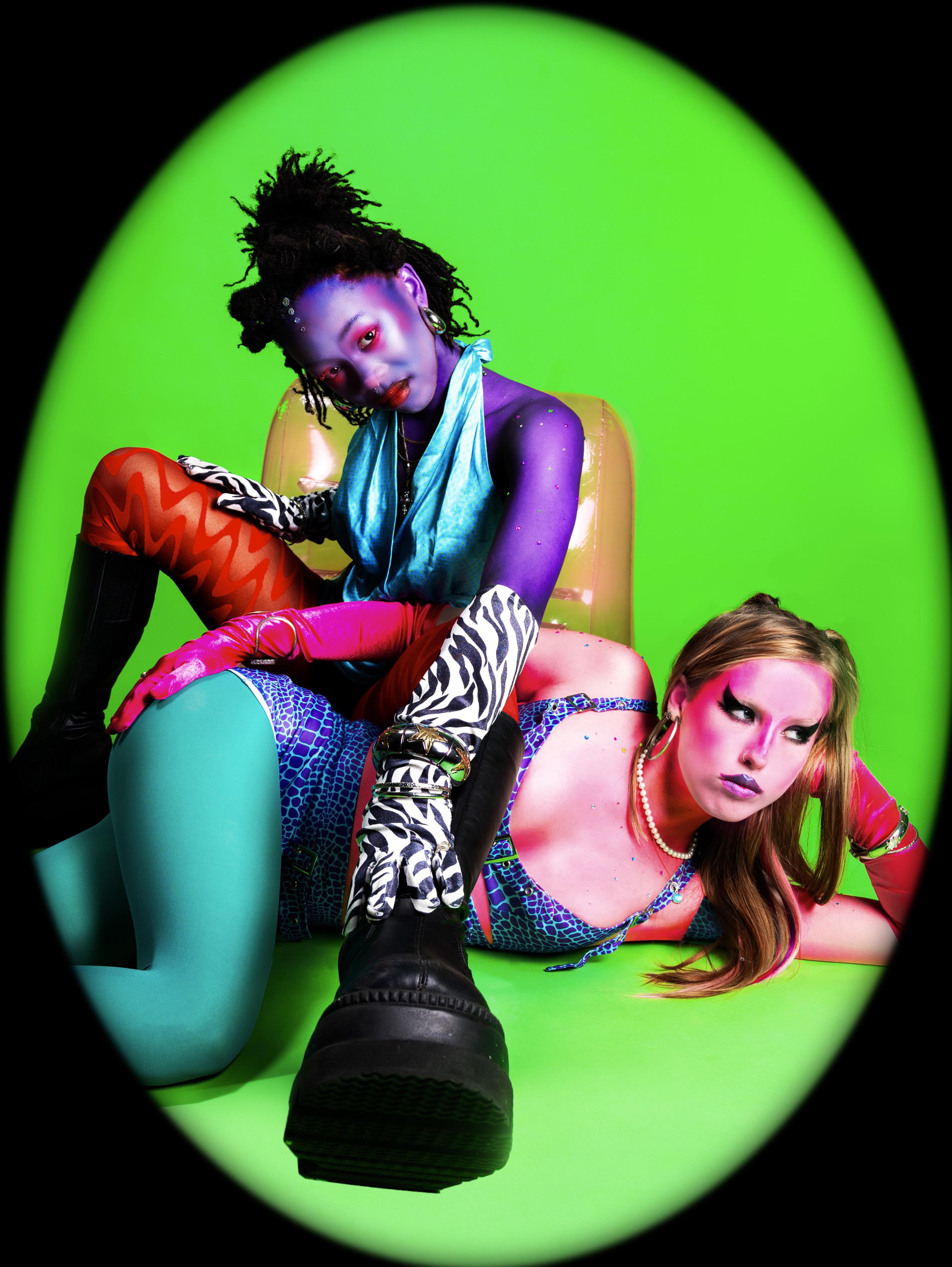
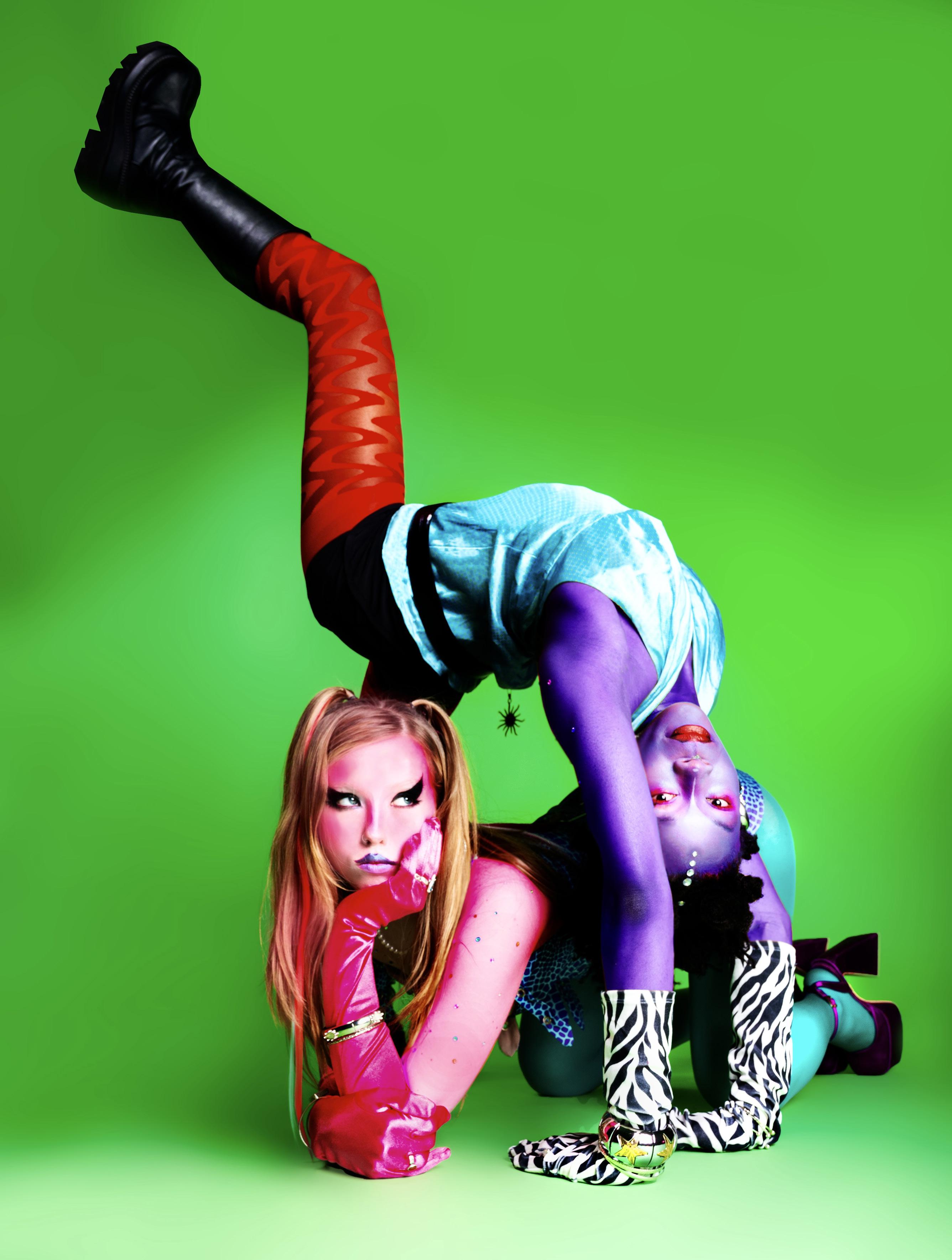 PHOTOGRAPHY BY: TAAY JAACK
PHOTOGRAPHY BY: TAAY JAACK
On any night out you can find countless girls sporting a corset top or a lace bodysuit, but pieces like these were once considered strictly reserved for intimate moments with your partner.
Once considered “lingerie,” we have seen fashion trends defy what was once deemed “inappropriate” for a night out — or in public at all. But, why have we seen this shift occur? Is it to appease the male gaze, or does it signify a larger shift regarding female sexuality and freedom?
as Princess Polly, half of the dresses are silk with lace. Which is essentially what 90s lingerie looked like,” Foto says.
Adrianna Foto, a PSU senior studying information sciences and technology and an active member of the Fashion Society at, says that this could be a result of the rise of thrifting.
“If you walk into any thrift store, you can easily find vintage lace and silk pieces, like slip dresses, matching sets or even corset tops, in the lingerie or loungewear section,” Foto says. Lace, silk and mesh are hot commodities in the world of fashion. As thrifting has become more mainstream, larger fast fashion companies have recently even begun to sell pieces that mimic the delicate “vintage” look shoppers tend to look for when they are thrifting.“If you look at brands such
Although historically lingerie is often linked to intimacy, when you strip it all down, it was really just meant to serve as an undergarment. Julia Bendlin is a fourth-year Penn State student majoring in pharmacology and toxicology and a member of the Fashion Society. She says the shift in how we incorporate lingerie is more about the evolution of fashion itself and the figures we want to achieve. “From a conceptual perspective, undergarments, such as corsets, were meant to make designer or elaborate pieces look more accentuated,” she says. “You know, small waist, big gown. But now, the piece being accentuated is the body.” Much of styling is all about achieving a certain silhouette. Trying to present an hourglass figure leads us to follow the small top/big pants rule. “When your clothes fit tightly, simulating essentially what a corset would have, there’s nothing left to accentuate besides our bodies,” Bendlin says.
Essentially, Marie Antoinette walked so
you could run. While I doubt she would ever wear a bedazzled Victoria’s Secret corset for a night out on the town — it just goes to show how the line between underwear and outerwear has become gradually blurred. Both designers and brands have created pieces that challenge the distinction between lingerie and regular clothing, making it more acceptable to incorporate lingerie elements into everyday looks. Trends like this one signify a larger shift in embracing creativity and female empowerment above all else. “When you wear risque pieces, it’s really a concept tease. It says ‘You can see me but you can’t touch me. I’m an artifact, an art piece. I’m a painting behind a glass frame,’” says Bendlin. It is all a part of a larger “take back” culture, by incorporating lingerie-esque pieces as casual wear, it no longer makes it taboo.“The free-the-nipple movement, for example, is the call to rid of the overt sexualization of the female body and instead view it as art –– that’s fashion,” she says. Wearing skin-bearing pieces might not be the innovative feminist movement people might have imagined, but it does say something about girlhood. Clothes are no longer confined to being titled as strictly reserved for the bedroom or as strictly going out clothes. When you look good, you feel good. All that matters is the confidence you wear with it.
64




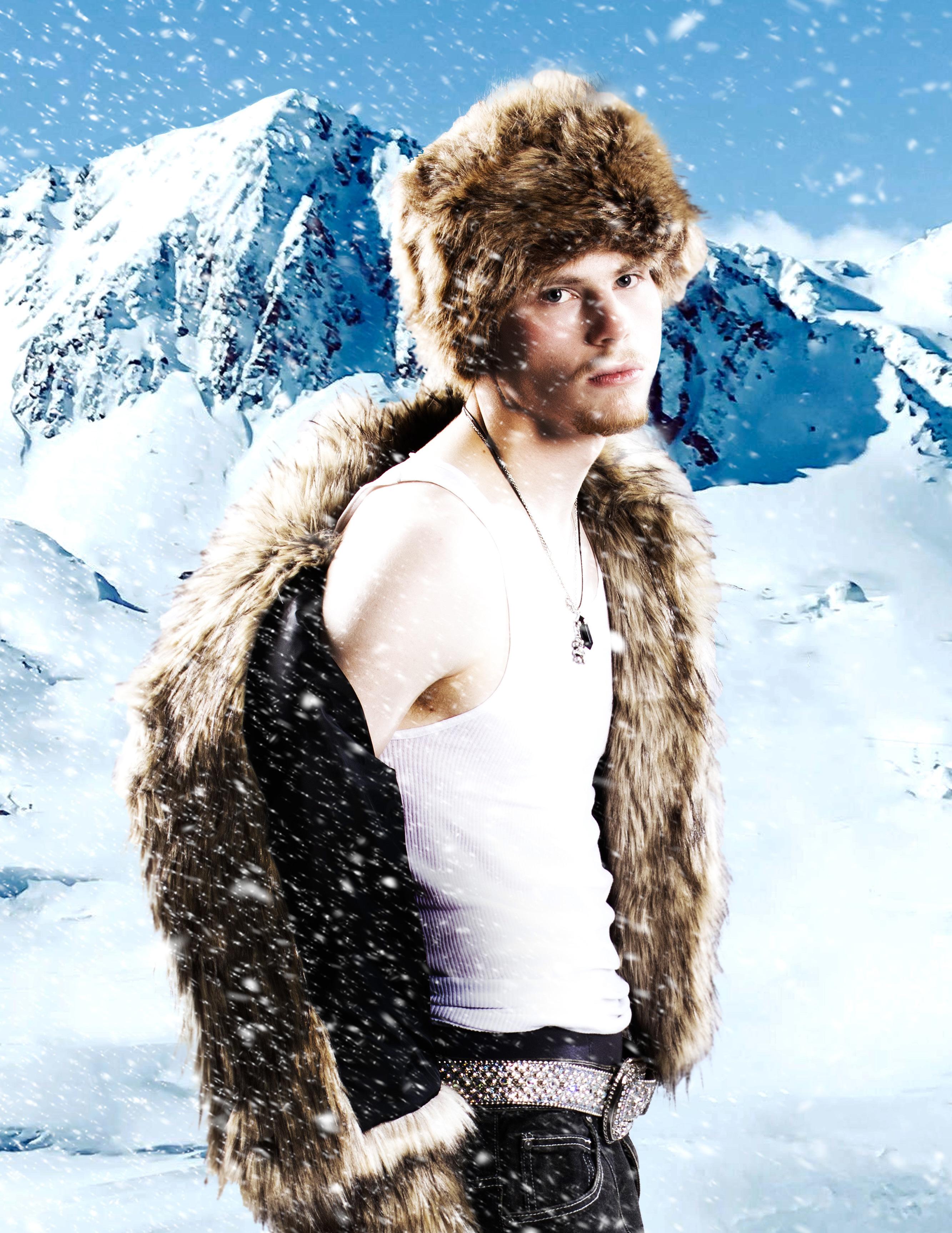
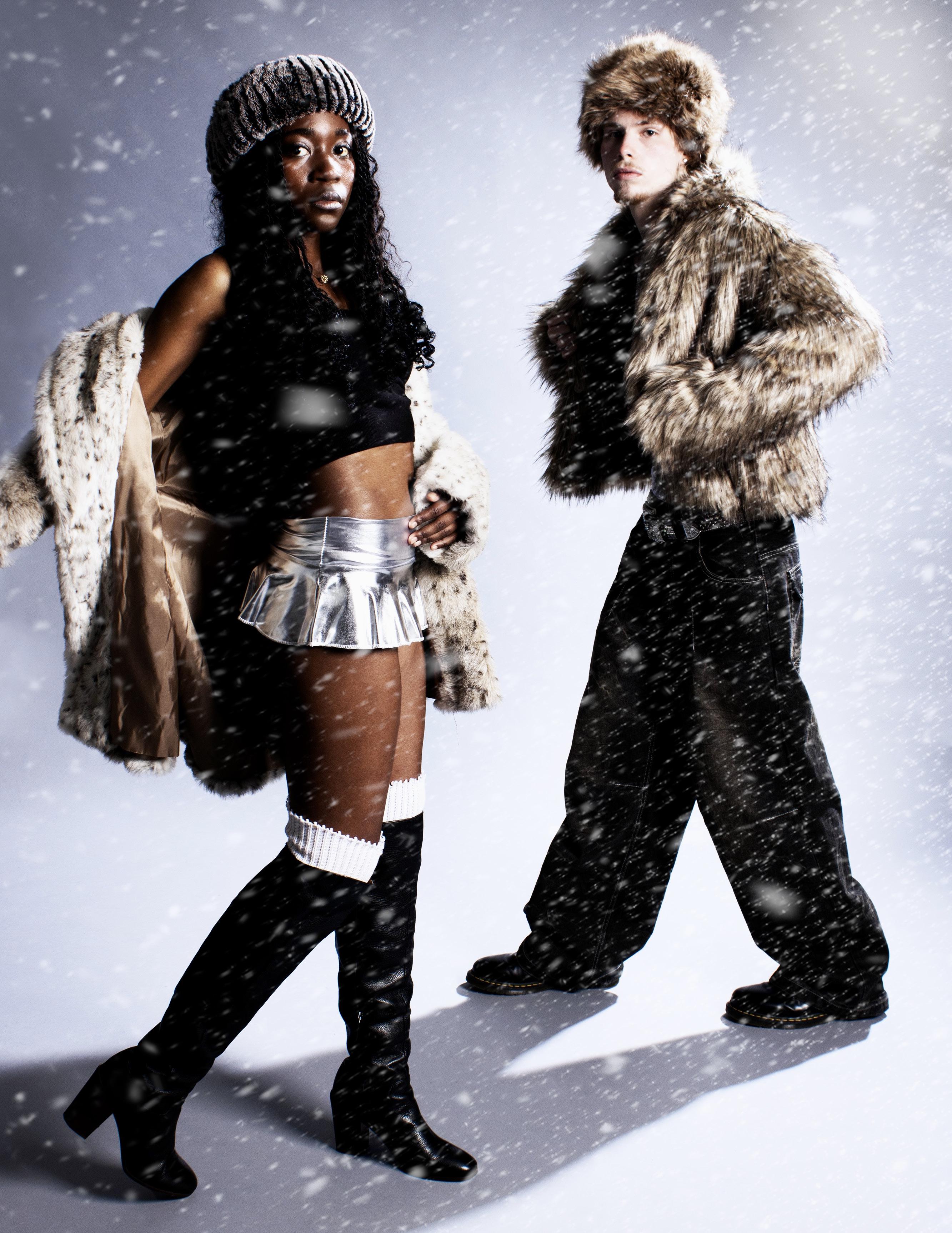
FROM:
@platosclosetstatecollegepa PHOTOGRAPHY BY: KAYLA MARCH
CLOTHES
PLATOS CLOSET


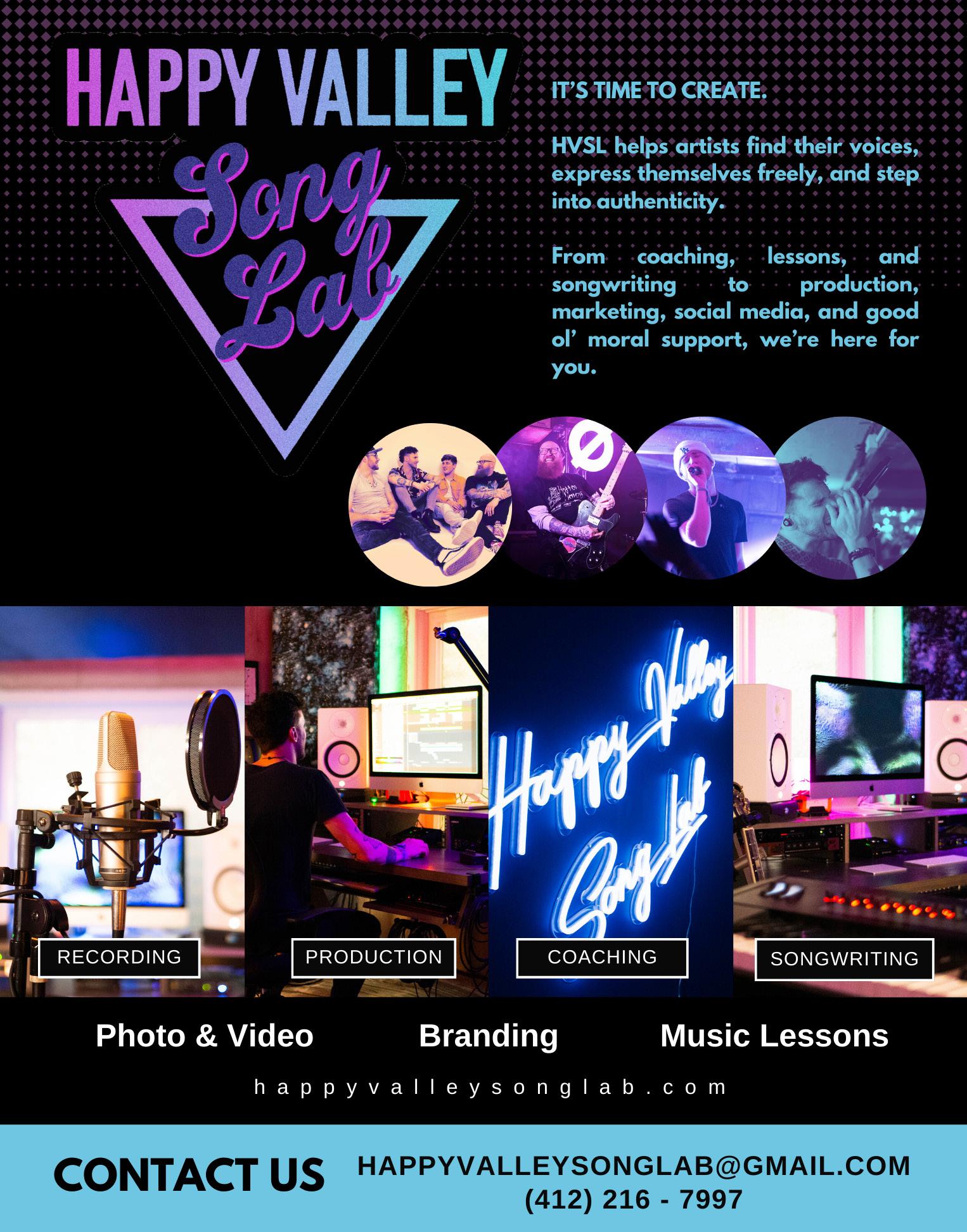


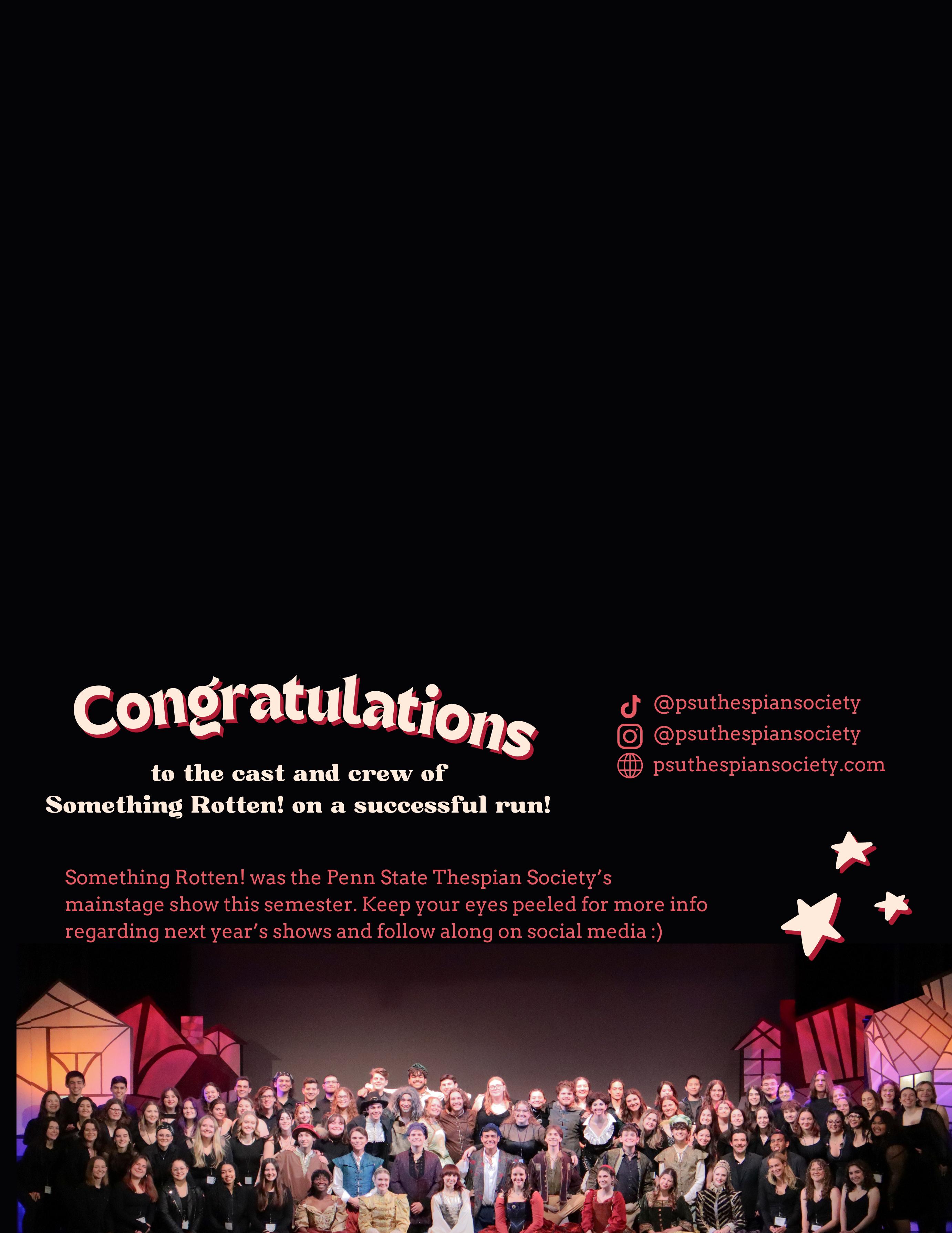

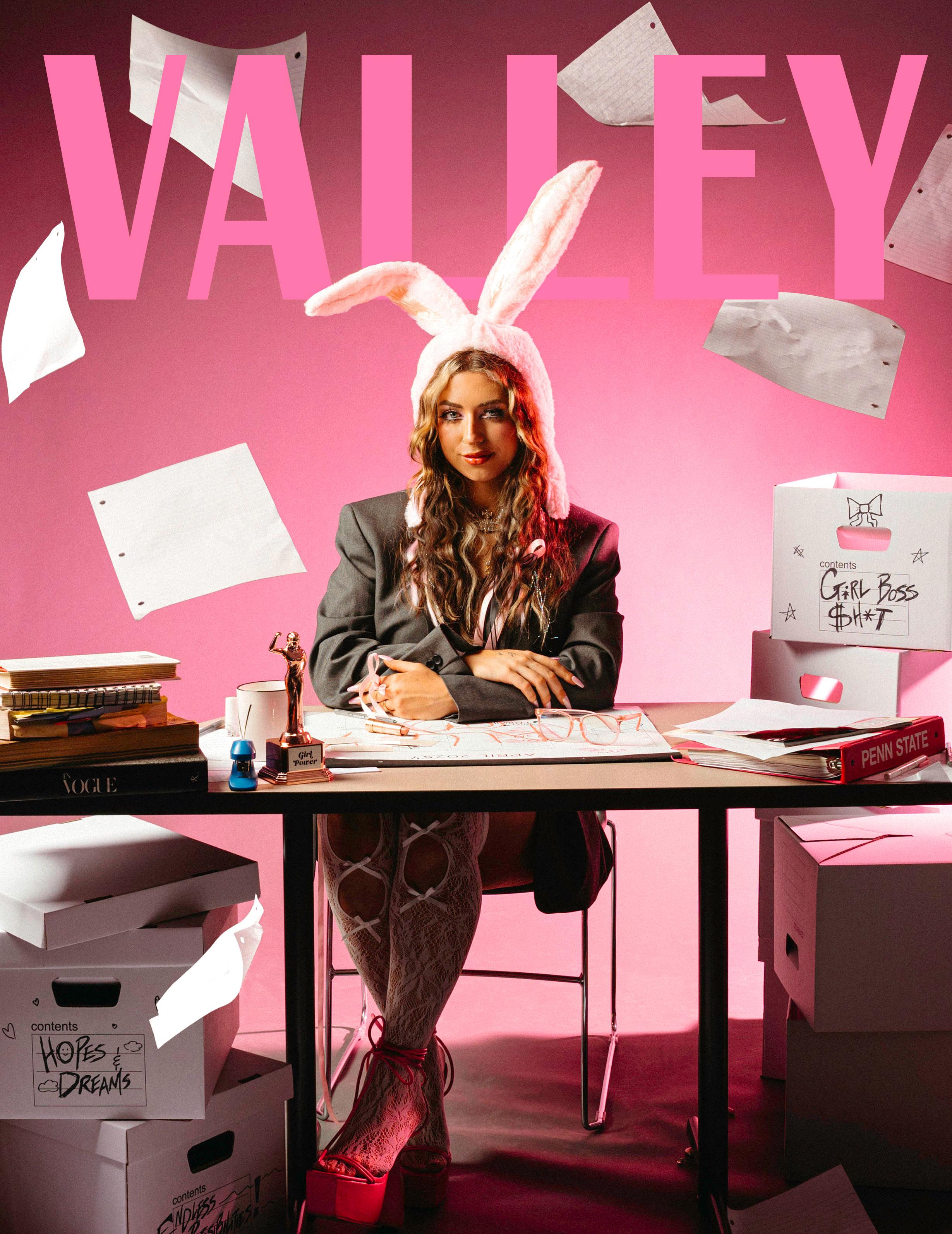











 PHOTOGRAPHY
PHOTOGRAPHY
















 WRITTEN BY DANI ARCARO
WRITTEN BY DANI ARCARO
 PHOTOGRAPHY BY: MICHAEL LANCIA
PHOTOGRAPHY BY: MICHAEL LANCIA


















 PHOTOGRAPHY BY: TAAY JAACK
PHOTOGRAPHY BY: TAAY JAACK












